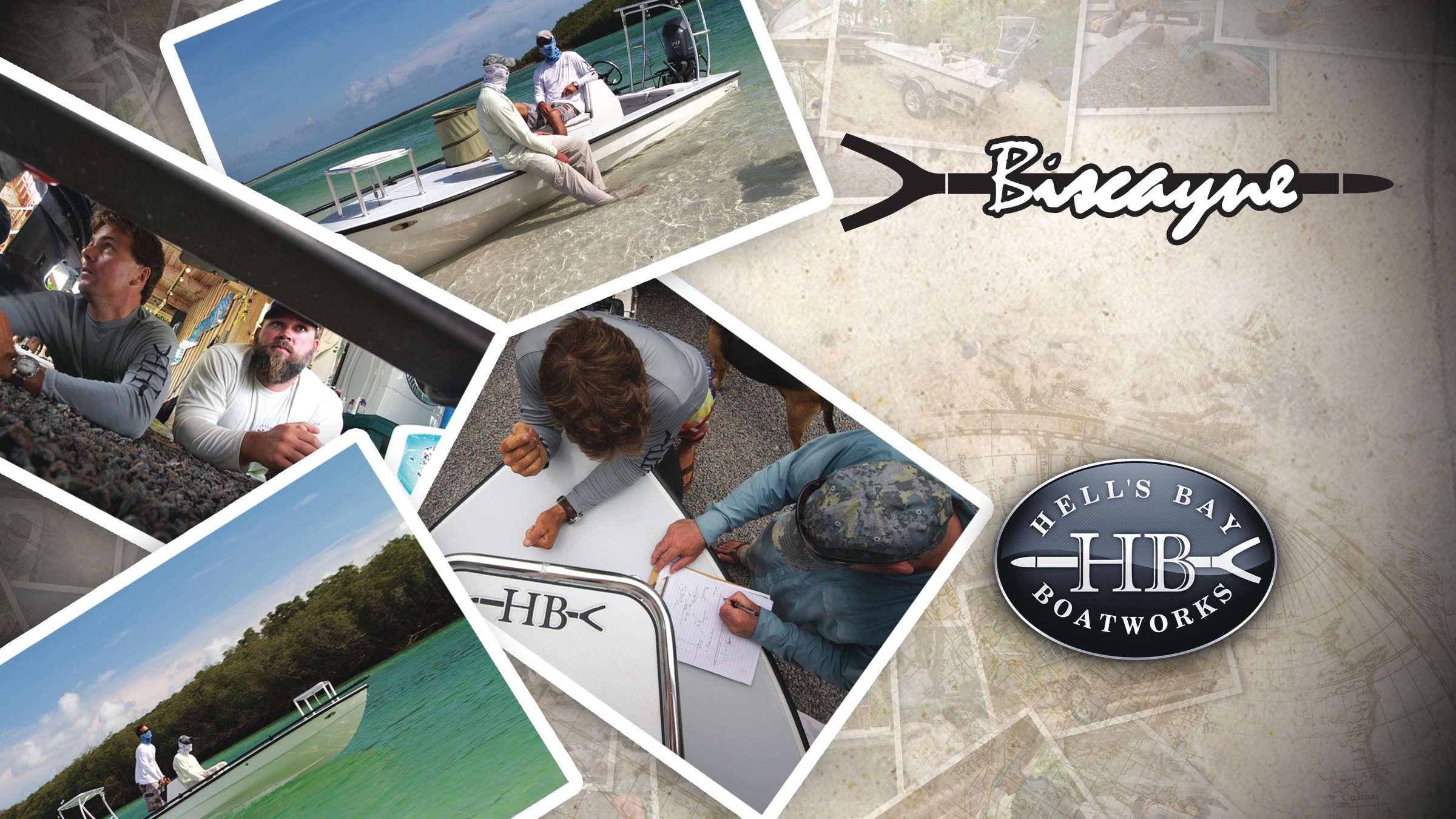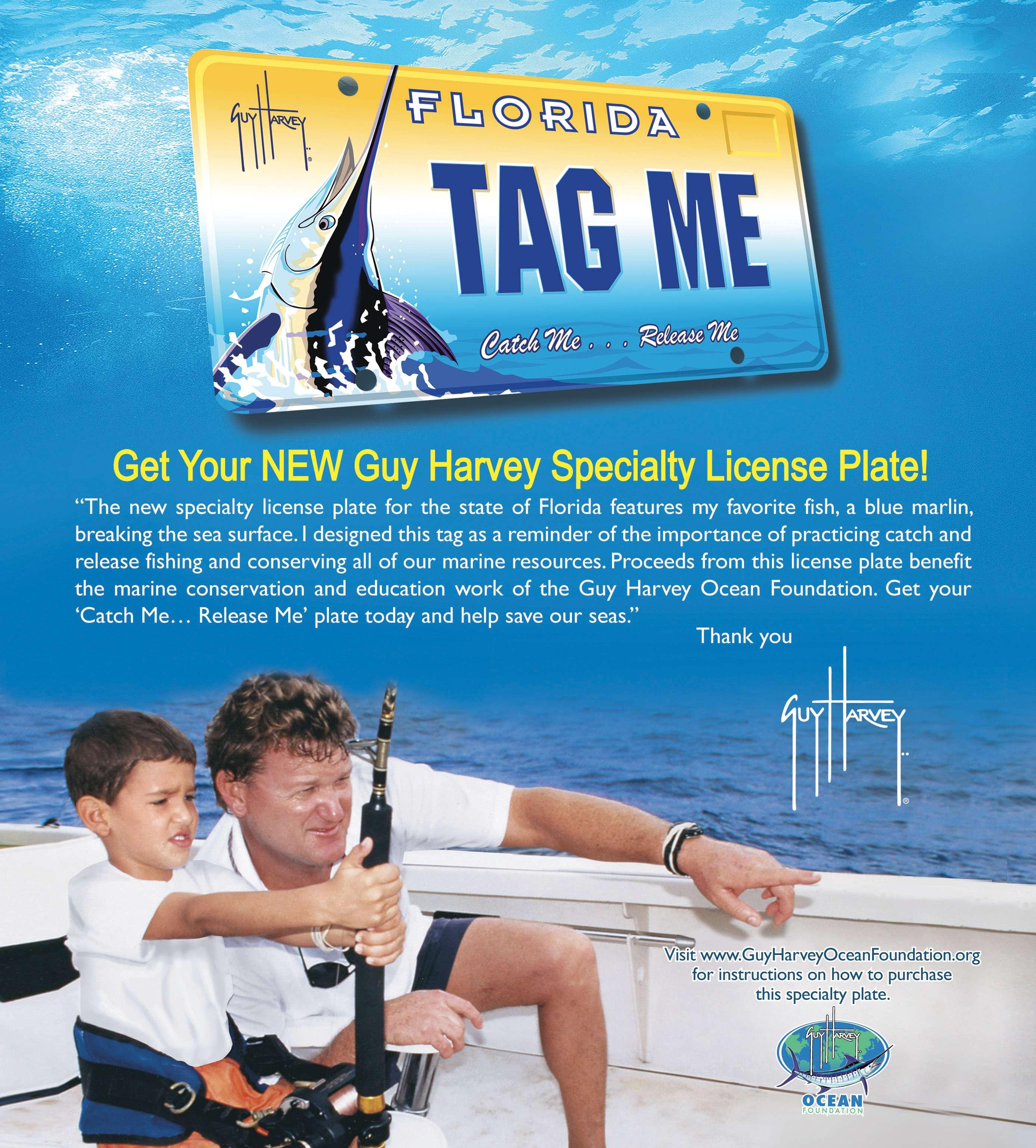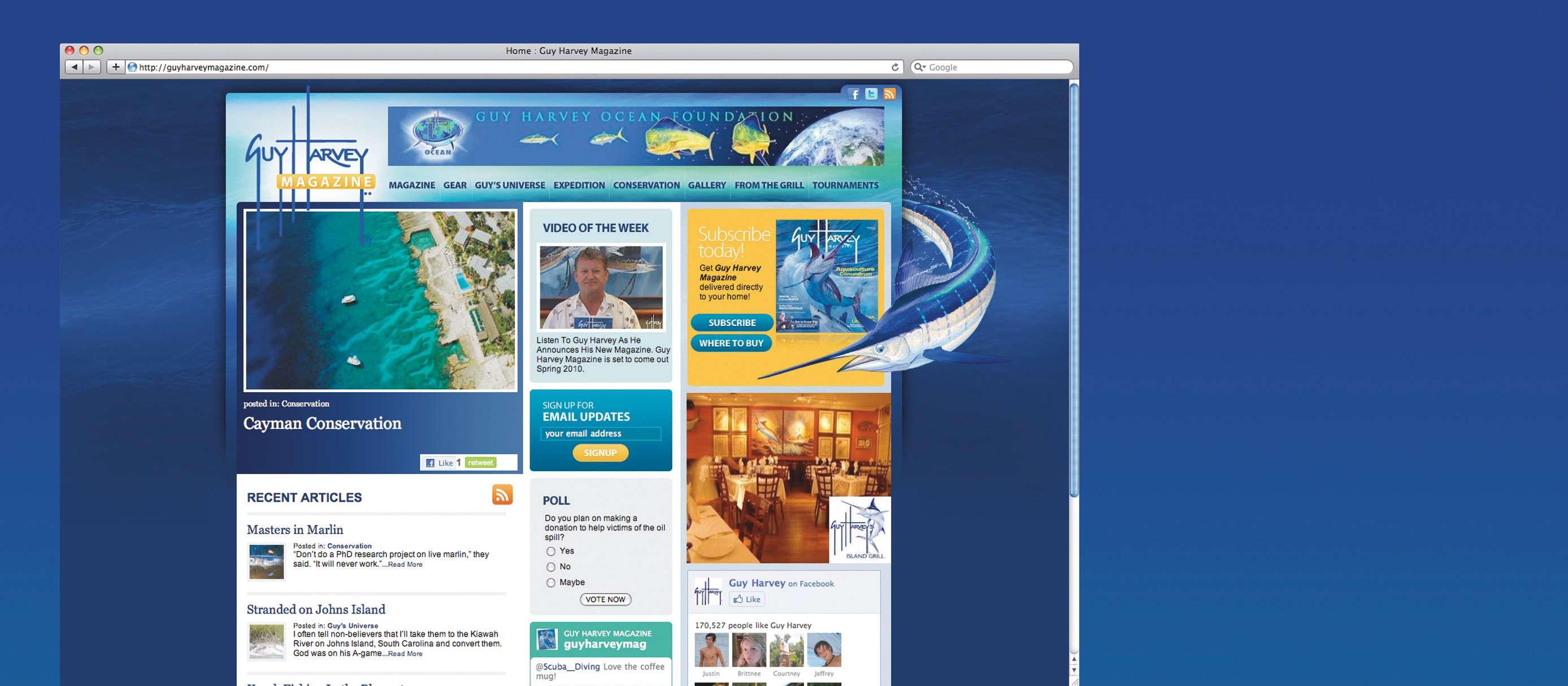
76 minute read
guy oNlINE
by JOHN GUIDROZ
Check out the new site at
www.guyharveymagazine.com
Mags for Free
What?! Your friend is not a subscriber to Guy Harvey Magazine??!! That’s just not cool. To show everyone (that means your friends, also) how incredibly awesome our magazine is, we have decided to offer everyone a free test drive. All we ask is that you tell the world about us.
Here is how it works… Go to HYPERLINK:
GHM Facebook — Picture of the
Month
http://guyha rveyma g .com
and watch the video of Guy Harvey introducing the new magazine. Then, scroll down and do one of the following:
-Tweet about Guy Harvey Magazine -Post on Facebook about Guy Harvey Magazine -Post on your blog about Guy Harvey Magazine
http://f ace book.com/guyha rveyma g azine
Step 3 — If people like it, we post it. If people love it, we put it in the magazine.
We can’t wait to see what you can come up with.

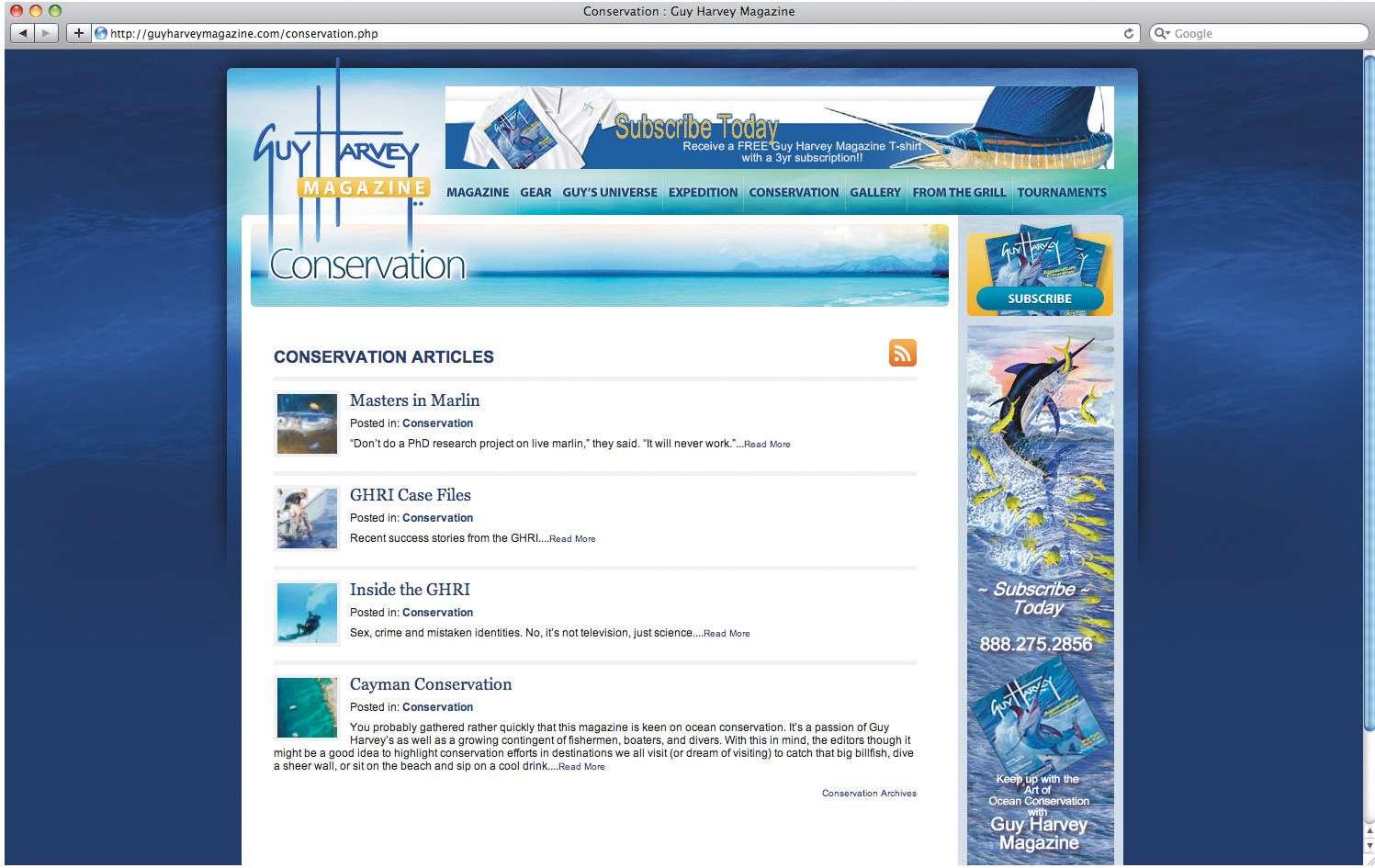
After we verify that your link is live, you can get one free issue of Guy Harvey Magazine. Existing subscribers can also cash-in and receive an additional issue tacked on to their current subscription. And, yes, you’re very welcome. Do you have an awesome picture that is worthy of being published in Guy Harvey Magazine? Well, here is your chance to show it off! Recently, we started posting some of the awe-inspiring images from our magazine onto our Facebook page. Our fans have responded and told us that they love this new feature. So, now it’s your turn!
Step 1 — Take a killer picture that is Guy Harvey worthy.
Step 2 — Upload and describe your picture at HYPERLINK:
Be sure to check out Guy on Facebook


his is a struggle for survival. It’s raw and furious, a roiling battle between opposing ends of the food chain, with very different survival strategies. At one end is a mass of sardines seeking safety in numbers. At the other are apex predators, armed with speed and teeth. The drama plays out each year when massive schools of sardines follow nutrient-rich waters, driven south by winter storms in the northern Gulf of Mexico, to the Yucatan Peninsula. Drawing the sardines up from deeper water onto the continental shelf, currents lure the sardines into prime hunting grounds of dolphins, sailfish, and bonito.
The sardines aggregate in massive schools, using their sheer numbers as their primary form of defense. The predators, of course, rely on stealth, speed, and a surprising synergism. The first maneuver is made by the sailfish, as they isolate a mass of sardines from the rest of the school, forming a smaller and more manageable baitball, which becomes a whirling blur of scales. The sailfish then set upon the ball with an insatiable appetite. Working as a unit, the sailfish begin to drive the sardines up from below, maintaining the tightly-packed ball by vigilantly guarding the perimeter. Other sailfish take position under the ball preventing the sardines from making a dash back to the safety of the larger school below. The scene is tightly controlled to maximize the sailfish’s chances of success. But, just as the perfect moment to attack approaches, the scene is shattered by a school of marauding bonito tuna.
Speedy as they may be, the sailfish are no match for the torpedo-like bonito. The bonito drive the whirling ball of sardines swiftly to the surface. The onslaught is relentless, and the ball shrinks rapidly. Dinner is disappearing fast, and the sailfish charge in to reclaim control of the ball. For a few moments, the bonito fight to regain position, but the razorsharp bills of the sailfish are daunting; one well-placed slice from the bill of a sailfish and it is game over for a bonito. The bonito retreat.
Below, large numbers of sailfish gather again to maintain the floor, while around the ball, sailfish continue to circle. When the ball approaches, they throw up their sails to block it. With the ball stabilized, sailfish take turns in the feast. When it’s time to strike, the animal hoists its sail and sends ripples of flashing color down the length of its body, perhaps The sailfish employ cooperative hunting tactics and form a wall to block the retreat of the sardines while one sailfish moves in to feed.


to signal to their cohorts that it’s their turn to strike, or perhaps to mesmerize their prey. Launching a strike from below and charging through the wall of baitfish, they use their bills to strike and stun the sardines. Scales fly and the injured sardines are separated from the safety of the ball and quickly snatched up in the bills of the sailfish. Frigate birds patrol from above, and as the ball is pushed toward the surface, they dive in and snap up sardines in their beaks. An occasional pelican joins them, but the birds are cautious. There are serious occupational hazards involved with diving into a sea of sailing daggers. The assault continues and the dwindling sardines are picked apart from below, above, and all sides.
The fate of the sardines appears to be sealed, but again the hunt is interrupted. Picking up the tantalizing sound of swatting sailfish bills, a small pod of spotted dolphins cruise in to investigate the possibility of an easy meal. The interlopers circle the sardines a few times, looking for an opportunity to make their grab, and when the window opens, they dart in for a try. However, the sailfish far outnumber the dolphins, and having already relinquished control of the sardine ball once to bonito, the sailfish do not intend to let it go again. After a few quick passes, the dolphins recognize this and move on.
Not long after the spotted dolphins depart, the orchestra of activity is shattered again, a testament to the many predators that patrol these waters. In this case, it’s a larger pod of rough-tooth dolphins, looking to replenish their energy stores on the calorie-rich sardines. They are also teaching a young dolphin in the pod to hunt. The dolphins crash in on the baitball. The sailfish, having worked for hours to stabilize the baitball, back down in deference to the larger and more powerful dolphins. The dolphins alone, however, are not enough to contain the baitball, and in the confusion, the sardines break and are on the run again. The faster sailfish race after the baitball and surround it, barely containing them before the sardines attempt to dive for safety. This time the dolphins approach more slowly, deferring to the sailfish’s superior speed. This cross-species cooperation benefits both parties.
The sailfish operate the perimeter and the floor while frigate birds work at the surface, and the dolphins take control of the center of the ball. Working in unison, the dolphins roll, twist, and twirl through the sardines, snapping at the fish with their rough teeth, specially designed just for
this sort of task. With each pass, they snag fish, give them a quick chew, and swallow them down. In the confusion of the melee, some fish slip through the dolphins’ teeth and make a run for safety. The sailfish are waiting for this moment. The instant a sardine breaks from the group, a sailfish launches in lightning-fast and snaps the fish into its mouth. Once the dolphins and sailfish start working together, the sardines don’t stand a chance. One by one, they are picked off until only a dozen or so remain.
Exhausted, injured, and overpowered by the predators, the stragglers are driven to the surface. Now comes the finale, and in a flurry of action, the sailfish and dolphins pounce on the remaining sardines and finish them off. Silver scales shower down through the deep blue water and the predators disperse as quickly as they appeared. One lone sardine somehow escapes the attention of the predators and feebly attempts to swim away. However, the injuries it has sustained from hours of dodging sailfish bills, bonito assaults, and the teeth of the dolphins prove too severe, and rolling over, it slowly drifts down into the blue abyss.
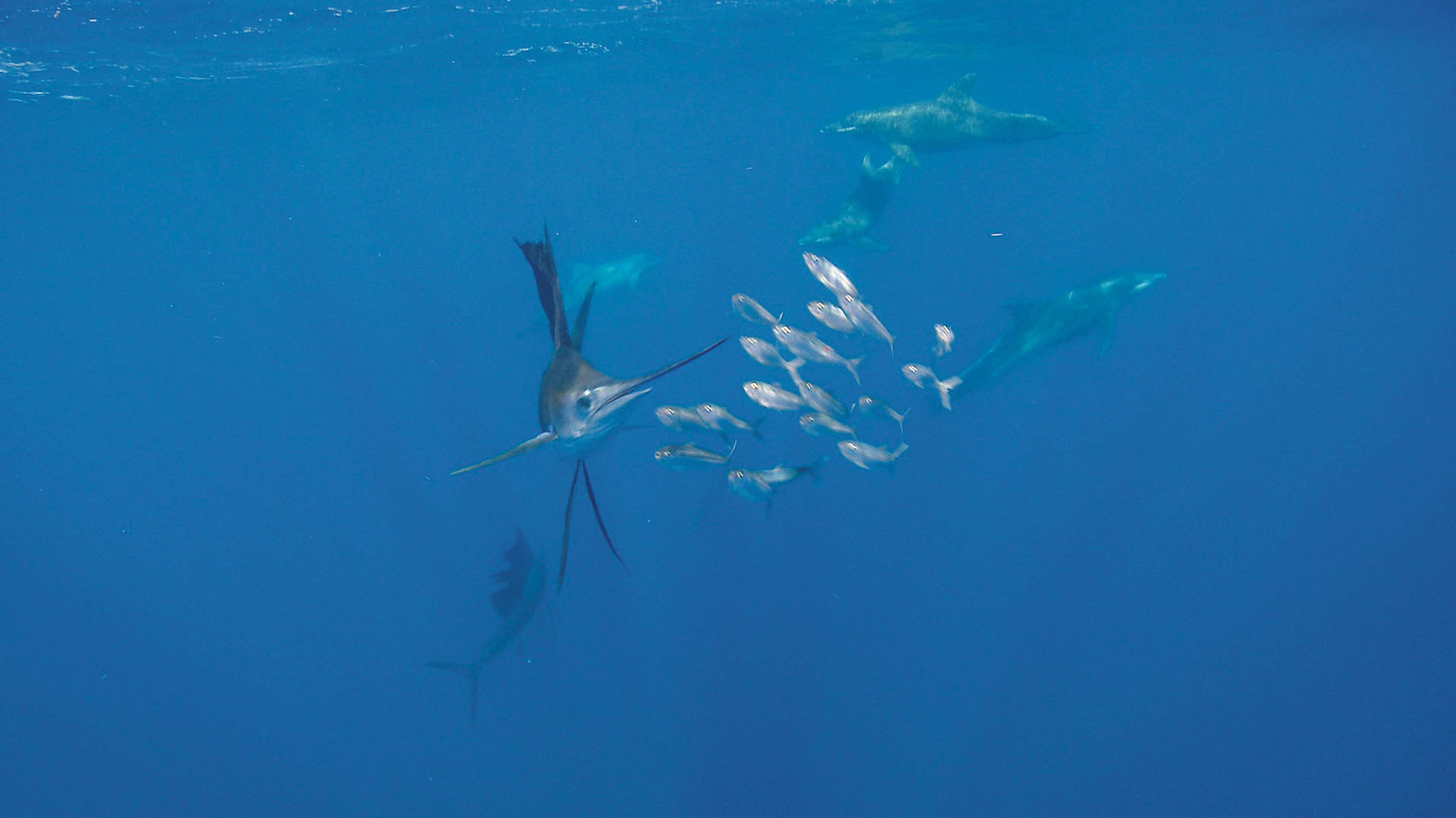
A New TreNd
When I first began filming the sailfish baitballs several years ago, I caught a brief glimpse of a pod of unusual looking dolphins chasing sardines along with the sailfish. This piqued my interest, and ever since that moment, I have aspired to document dolphins and sailfish hunting in concert.
The following year, I was extremely fortunate when a small pod of spotted dolphins investigated me during a sailfish baitball. Though they made a brief pass through the ball, they seemed less interested in the sardines than they were in me. I have experienced lengthy encounters with spotted dolphins on many occasions in the Bahamas, but in these waters, they are typically shy and elusive. Even when observing from the boat, our crew noticed that when dolphins hit the baitballs, the sailfish would scatter and the action ended abruptly. Our captain, Rogelio, and the crew from Keen M International, who have worked these waters for more than 30 years, confirmed our observations. Never once had Rogelio seen sailfish and dolphins hunting together, and to his knowledge, no film crews who have worked with him have ever captured the behavior.
This season, however, my encounter with the dolphins was a different story. While the sailfish guarded the floor The speed of the sailfish as they feed is stunning as they race into to strike the sardines.



and perimeter, much like sharks in the sardine run, the rough tooth dolphins worked the inside of the baitball, constantly chasing and feeding on the sardines. When a dolphin managed to isolate a sardine, the sailfish would seize the opportunity and devour the sardine with unfathomable speed and precision. Both dolphins and sailfish worked to their strengths and relied on the other species to cover the gaps. Given the degree of coordination the two species exhibited in their hunting behavior, it appeared deliberate and natural to the animals involved. To the best of my knowledge, this symbiotic relationship has not been previously documented or scientifically described.
To witness this behavior off Isla Mujeres is also a testament to the conservation efforts being made in the area. Isla Mujeres, located in the northern Yucatan Peninsula of Mexico, is just a 30-minute ferry ride from Cancun. Despite its proximity to this bustling city, the waters surrounding the island are rich with game fish, whale sharks, manta rays, and all sorts of other marine life. Perhaps more than anything else, it is the massive schools of sailfish chasing shoals of sardines that sets Isla Mujeres apart and attracts anglers from around the world.
Sadly, overfishing has impacted most commercially valuable large fish. Some scientists estimate that in the past 50 years, more than 90% of all large fish have been removed. Billfish have not been spared. However, the bill fishing community in Isla Mujeres had the foresight to recognize the economic and ecological importance of managing their seasonal sailfish stocks. Sport fishing boats operating out of Isla Mujeres operate on a catch-andrelease basis. However, even catch-and-release can result in significant losses when sailfish swallow J hooks and tear up their insides. In response, operators in Isla Mujeres are now adopting circle hooks, significantly reducing the potential for swallowed hooks snagging the gut. These policies, along with a concerted push by the community to shield the sailfish from exploitation by commercial fisheries, are creating a bright future for tourism that hinges upon the continued protection of the magnificent sailfish.
In each successive year, I have observed more and more sailfish predating on the sardines. Perhaps a variety of factors beyond our understanding is driving these observed increases. Or, maybe we are witnessing the exciting role a properly managed catch-and-release sport fishing industry can play in safeguarding valuable fish species.

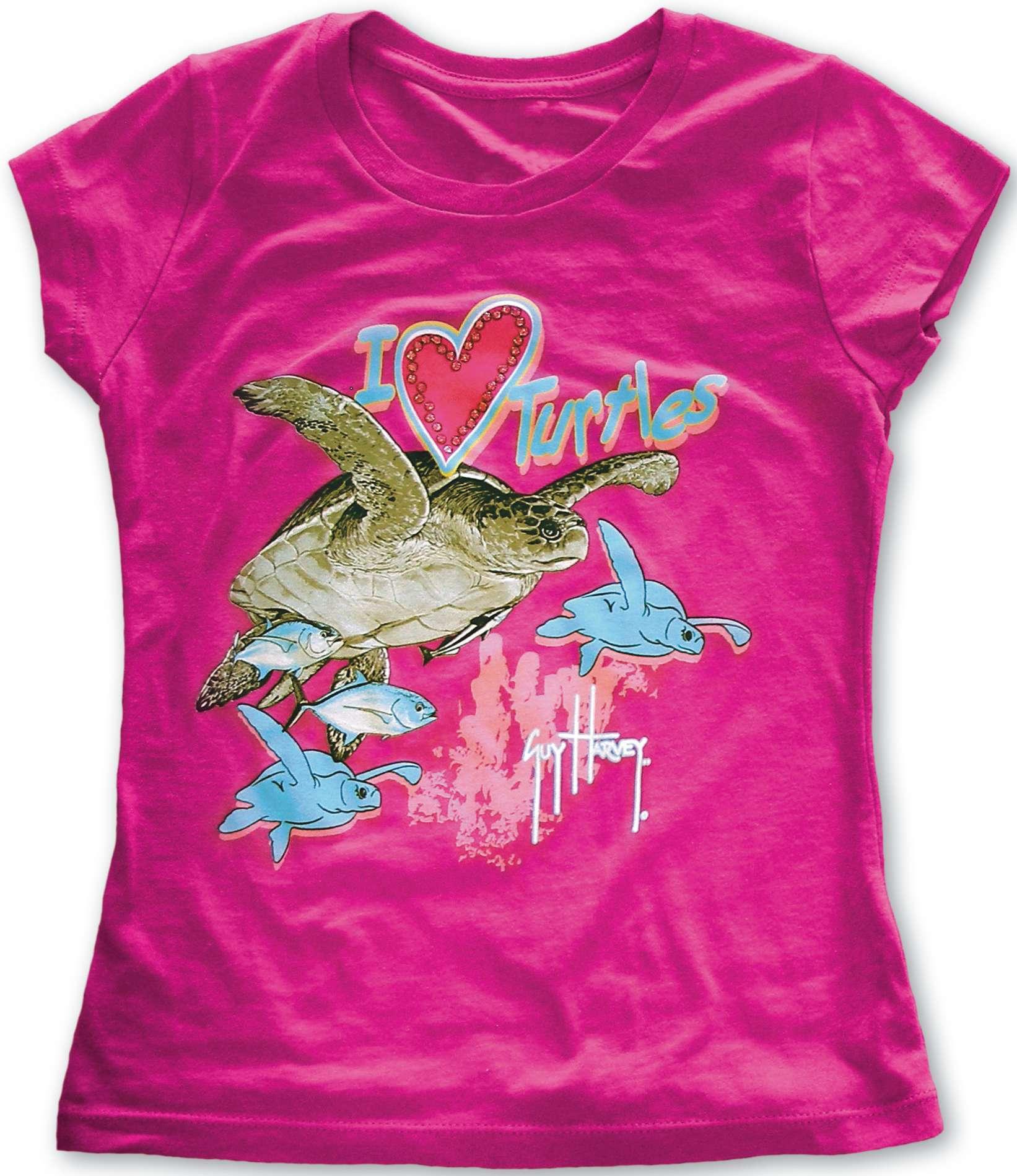
y 11-year-old daughter came home from school recently wearing her favorite pink Guy Harvey T-shirt. “Daddy, there’s a girl in my class who has never heard of Guy Harvey,” she said. “What’s wrong with her?”
I laughed. “So did you tell her about Guy?”
She raised her eyebrow at me. “Of course I did, daddy!”
The expression was eerily like her mother’s. Wonder where she learned that?
Back in the old days, Guy’s popularity gained traction with the hardcore, blood-and-guts fishing community. The art struck a nerve and the fish stains washed out easily enough. Now GH apparel is gathering steam with a wider demographic, including little girls who love pink and think fish stink. In fact, the fastest-growing fan base is school kids—from college on down to kindergarten.
“This is a brand that has crossed all ages and genders,” said Dick Nagel, vice president of sales and marketing at AFTCO, the company that makes Guy Harvey apparel. “I’ve never seen anything like it.”
That’s saying a lot. Nagel, a silver-tongued Missourian who’s lived in California for 30 years, has been a marketer for the likes of Nike and studying the Gulf of Mexico after the oil spill, tracking shark migrations, developing new ways to DNA-test seafood, tagging billfish and sharks, and supporting dozens of other projects to help protect important and threatened oceanic species. And it all begins with a simple Hanes Beefy T.
“We’re very fortunate to have a source of funding for the GHOF,” said Dr. Guy Harvey. “Without the sale of Guy Harvey apparel, we wouldn’t be able to accomplish the scientific research we’re doing. We also fund many other independent scientists that are outside of the GHRI but are involved in essential studies of the marine environment.”
a comFortable Fit
Some people might consider it sappy, but loyalty and ethics are core principles within the Guy Harvey organization, starting at the top with Dr. Harvey. So when Guy went searching for a T-shirt supplier back in 2004, he looked for a company that shared his values and commitment to the oceans. The search quickly led to the American Fishing and Tackle Company (AFTCO) and President Bill Shedd. Shedd is not only an avid sportsman but he’s spent most of his life working to protect the rights of fishermen, as well as the fish we catch. He was instrumental in getting
Ocean Pacific, both giants in brand merchandising.
“Normally, a product will appeal to a specific category such as older men or young women, but Guy’s shirts have crossed all boundaries.”
I had to agree. I’ve seen it with my own kids.
“There’s no doubt that the quality of the art is the most significant factor,” Nagel said. “Guy’s an avid scuba diver and fisherman, so he studies his subjects in their natural habitat. He’s a scientist, so he knows their behaviors. And he’s a highly talented artist. It’s a perfect combination that brings an accuracy and authenticity to the art.”
A flash of silver shimmered in my eyes as he spoke.
“Another major factor in the brand’s growth is its support of marine conservation. A portion of every sale goes to help fund the Guy Harvey Ocean Foundation. Young people identify with giving something back to the environment. It’s one of the reasons they’re our fastest growing customer base.”
In fact, the sale of Guy Harvey’s apparel is the largest source of funding driving the vital conservation work at the GHOF as well as the Guy Harvey Research Institute. While the GHOF funds research through grants, the GHRI does extensive scientific research on its own, such as longlines and gill nets banned from California waters—two initiatives that have had a major impact on allowing fish populations to flourish naturally.
“Before the gill net ban, fishermen were catching less than 2,000 white seabass annually in California,” Shedd said. “Now we’re back up to more than 10,000 each year (from a high of 60,000), so all indications are that the population is on the increase.”
Bill’s passion for the oceans is in his blood. His father, Milton Shedd, co-founded SeaWorld in 1964 and was a marine conservationist before the term even existed. Milt Shedd started the Hubbs SeaWorld Institute (HSWI) in 1963, named for Dr. Carl Hubbs, who was the world’s top ichthyologist at the time. The institute is thriving today with Bill Shedd as the chairman of the board.
A lot of HSWI’s work has focused on building hatcheries and getting the fishing community involved in conservation efforts.
“We have a white seabass hatchery here in Southern California,” Shedd said, “and the local sport fishermen contribute thousands of volunteer hours. We’re starting to do the same thing in Melbourne, Florida, and have other projects in the pipeline, too. It’s really important to get fishermen involved because we’re the ones who use the resource
the most and have the greatest passion for keeping it healthy.”
In 1973, Milt Shedd and his wife Peggie bought AFTCO and the company prospered with their top-of-the-line roller guides and roller tops for big game fishing rods. At some point, they’d saturated the market. Bill, who had been working under his father’s tutelage for more than 10 years, realized they needed to expand their product line.
“I thought about it for days and days and wondered what else we could make that fishermen needed. I finally had this idea to make fishing shorts. At the time, no one was making apparel focused on sport fishing. So I considered it, I prayed about it, and before long we were making AFTCO fishing shorts. Today, they are still the most widely used fishing shorts in the world.”
From shorts, AFTCO moved to shirts and other clothing products. not just because it’s a good business model. It also means there will be more resources to do the work that needs to be done on behalf of the oceans.”
Go West YounG Man
When asked how much research he does online versus how much time he spends in libraries, humor writer PJ O’Rourke responded, “You mean they still have libraries?”
It’s true, anything can be found on the Internet these days, but there’s also no substitute for an in-person research trip. So instead of digging into the Web, I hopped in the big metal tube and flew to the sunny shores of Southern California to see what this T-shirt thing was all about.
I linked up with Shedd on a Sunday afternoon and he immediately






Graphic artist Terry Simms preps artwork for printing (left). Simon Puril, Cody Shedd, Terry Simms, and Anne Holmes inspect a new shirt design (right).
These days, AFTCO still makes roller guides and roller tops, gaffs, Unibutt handles, outrigger release clips, belts and harnesses, fishing gloves, and other big game-oriented fishing products. But the T-shirt has become king.
After the Guy Harvey/AFTCO connection was cemented, the T-shirt sales tripled in the first two years. The growth continues and the apparel concept has expanded in all directions. Today, AFTCO offers Guy Harvey shoes, flip flops, hats, shorts, swim trunks, backpacks, jackets, performance fishing shirts, collegiate shirts, and the list goes on. The result has led to more good conservation work by the GHOF.
“It’s great to be in business with someone who shares the same passions and ideals,” Shedd said. “It has transcended business and become part of our lifestyle. Sure, we want to sell more products, but took me kayak fishing in the Pacific Ocean. In a previous life, I’d spent a good bit of time diving and spearfishing in California waters. This time, Bill taught me how to catch calico bass in the kelp and the nuances of launching a kayak into the oncoming surf. It’s tricky, especially with fishing rods, tackle, and my fear that a great white shark might mistake my kayak for a big, fat, orange seal.
A native California dude, Shedd is approaching 60 but has the perpetual tan, dark, thick hair, and the physique of someone who has enjoyed the West Coast playground his entire life. He played quarterback in high school, he lives at the beach, he surfs, he paddleboards, he scuba dives, and he drives a Prius. He’s a living, breathing advertisement for the California good life. His shirts say Guy Harvey, but I’m surprised he didn’t come up with the “Life is Good” clothing line.
“The Prius gets me access to the carpool lane,” he said. “That’s the main reason I bought it.” Sure, and he’s modest, too.
He and Jill, his wife of 30-plus years, have four kids all living in California. In the early 2000s, their son Cody and their daughter Christie stepped into AFTCO to keep the family tradition strong. Cody is a numbers guy, which comes in handy in his role as general manager. Christie’s outgoing personality is a perfect fit for her role in sales. The legacy continues.
My first stop Monday morning was a giant warehouse that reminded me of the last scene in Raiders of the Lost Ark, where the guy is wheeling the ark through an endless line of crates. But AFTCO’s boxes will not be lost forever. Several hundred thousand blank T-shirts await their turn to enter the world of Guy Harvey art. a T-shirt because of the different fibers, colored shirts, and the screenprinting process itself.
Magazines and newspapers combine just four-colors—black, blue, yellow, and magenta (pinkish)—to create a broad spectrum of colors. The same can be true with T-shirts. However, since moving to AFTCO, Guy Harvey shirts don’t use a four-color process anymore. The shirts that come out of AFTCO have between 9-14 colors and some have as many as 18.
“We want to make sure there’s an exact match to the art,” said designer Simon Purll. “That’s our primary goal. We might have five or six different blues in one design. Four-color process won’t cut it. It just can’t achieve a prefect reproduction of Guy’s original art.”
And that’s the challenge: take art from the canvas and put it on cloth

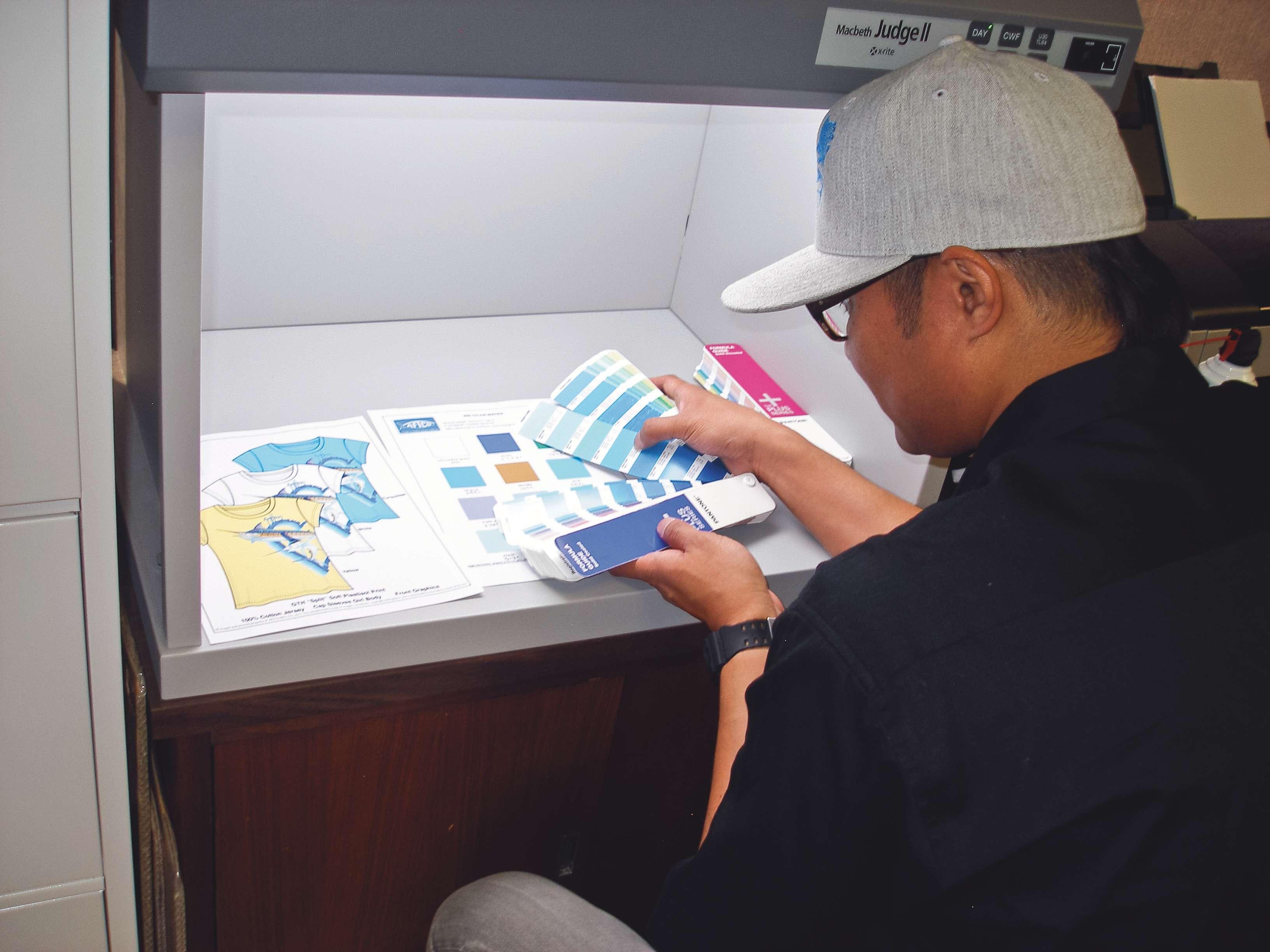




Daniel Santomin makes sure the colors are an exact match (left). Cody Shedd and Steve Restivo with a typical screen (right).
As the business has grown, inventory has spilled over into several other warehouses. After an exhaustive search, the Shedd/AFTCO team recently purchased a 117,000-square-foot facility to consolidate and house the entire operation. It’s close enough to retain their valuable staff, many of whom have been at AFTCO for decades.
“We’re very fortunate to have good people who work hard and focus on making great products and providing excellent customer service. We can ship 98% of any order within two to three days,” Shedd said. “And those are custom orders. A store can order as few as six T-shirts. Another client might order 10,000.”
Having been in the magazine business for some 25 years, I have some knowledge of the printing process. Putting ink on paper has similarities to printing on cloth, but it’s much harder to get an exact reproduction on so that the two images are one and the same. That begins with scanning the original art and modifying it so it will transfer to a T-shirt without losing quality.
“We might have to add more black to an outline or knock out some background scatter so that it translates to the shirt,” said graphic artist Terry Simms. “We spend hours and hours on the digital files of each T-shirt design to get them right.”
Design director Anne Holmes oversees the team as they move forward with new designs. “Some of the original designs such as the Grand Slam are still the most popular T-shirts,” Holmes said. “But we’re really expanding in our teen and kids divisions with new looks for kids that probably aren’t hard-core fishermen.”
I pointed out that my daughter sleeps in a pink Guy Harvey T-shirt
and only fishes when I make her go with me.
“Exactly,” Holmes said. “Fishermen love the shirts, but so does the general public.”
Once the digital file is complete, the AFTCO art department sizes the image and places the art on various background colors in the computer, representing different colored shirts. The final prep before heading to the printer is overseen by print specialist Daniel Santomin, who studies the colors like a scientist decoding DNA samples. He chooses colors that will print by using a white light box to get a solid starting point. Once they get to the printer and begin the sampling process, the colors they started with might change



based on differences in light, shirt color, base, etc.
“This is how we begin the quality control process and carr y it through to the end product,” Daniel said.
I watched the art team in action in their comfy ergonomic chairs and air-conditioned offices. Like the many magazine designers I’ve worked with, their’s is a world of high-powered, big-screened Apple computers, color printers, graphics software, and impressive iTunes collections. And even though there were no calluses in sight, they were about to show me where the real dirty work of the T-shirt business went down—putting ink to cloth at the screen printers.




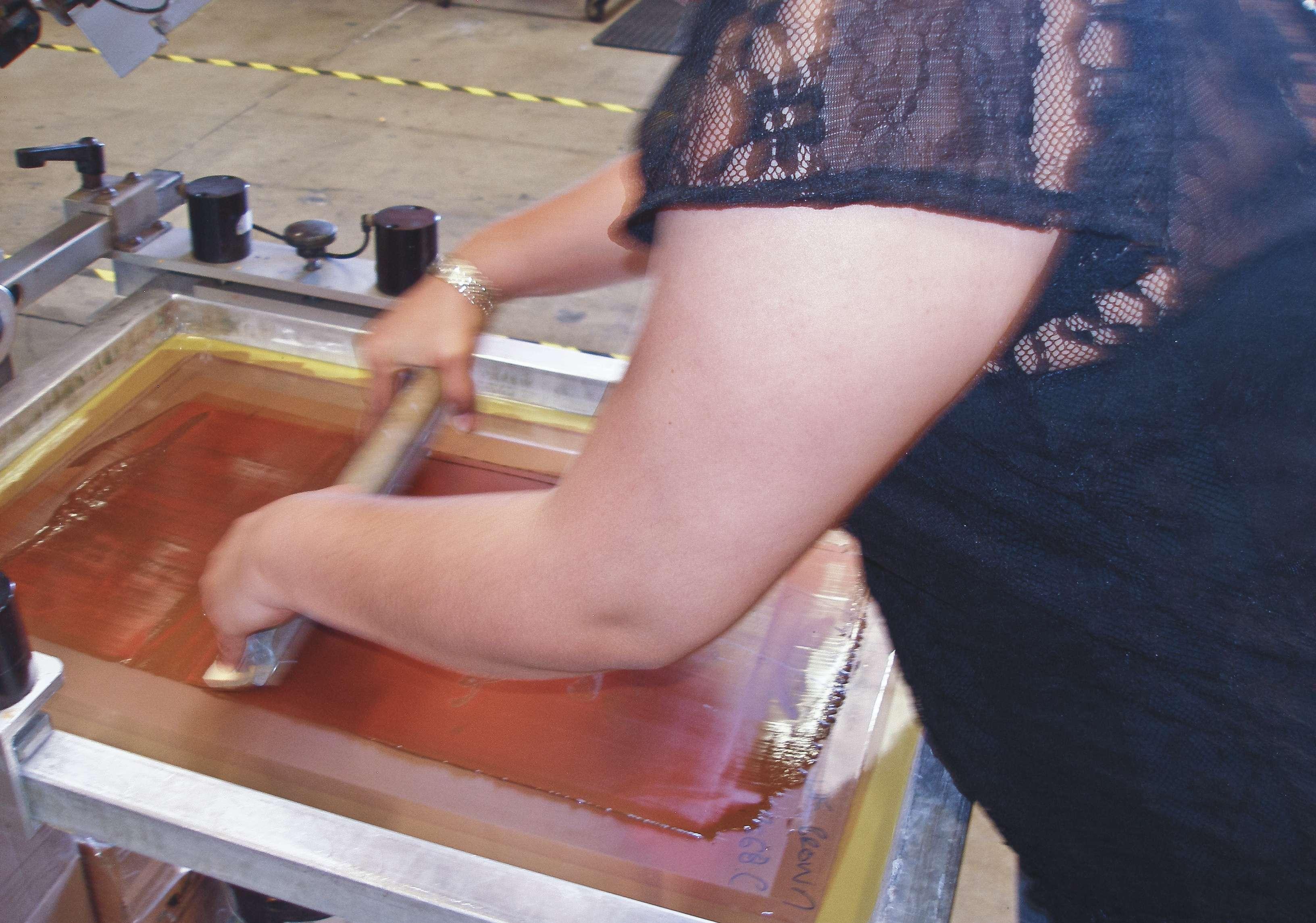







super cool
Southern California’s mega T-shirt industry is a byproduct of being located in the center of the surfing universe. The area has spawned companies like Body Glove, Ocean Pacific, Quiksilver, O’Neil, and Rip Curl, as well as Kings of Cool Culture like Tony Hawk, Rob Machado, and
Shaun White. Other places might have great surfing, but there is no argument that So-Cal is a teeming cheese fondue of ultimate hipness. That’s why the hottest decals and T-shirt designs have been born of the blonde, bronzed, beachiness that runs from San Diego to Santa Barbara. And I’m a Florida boy, so accepting that I’m a lower primate


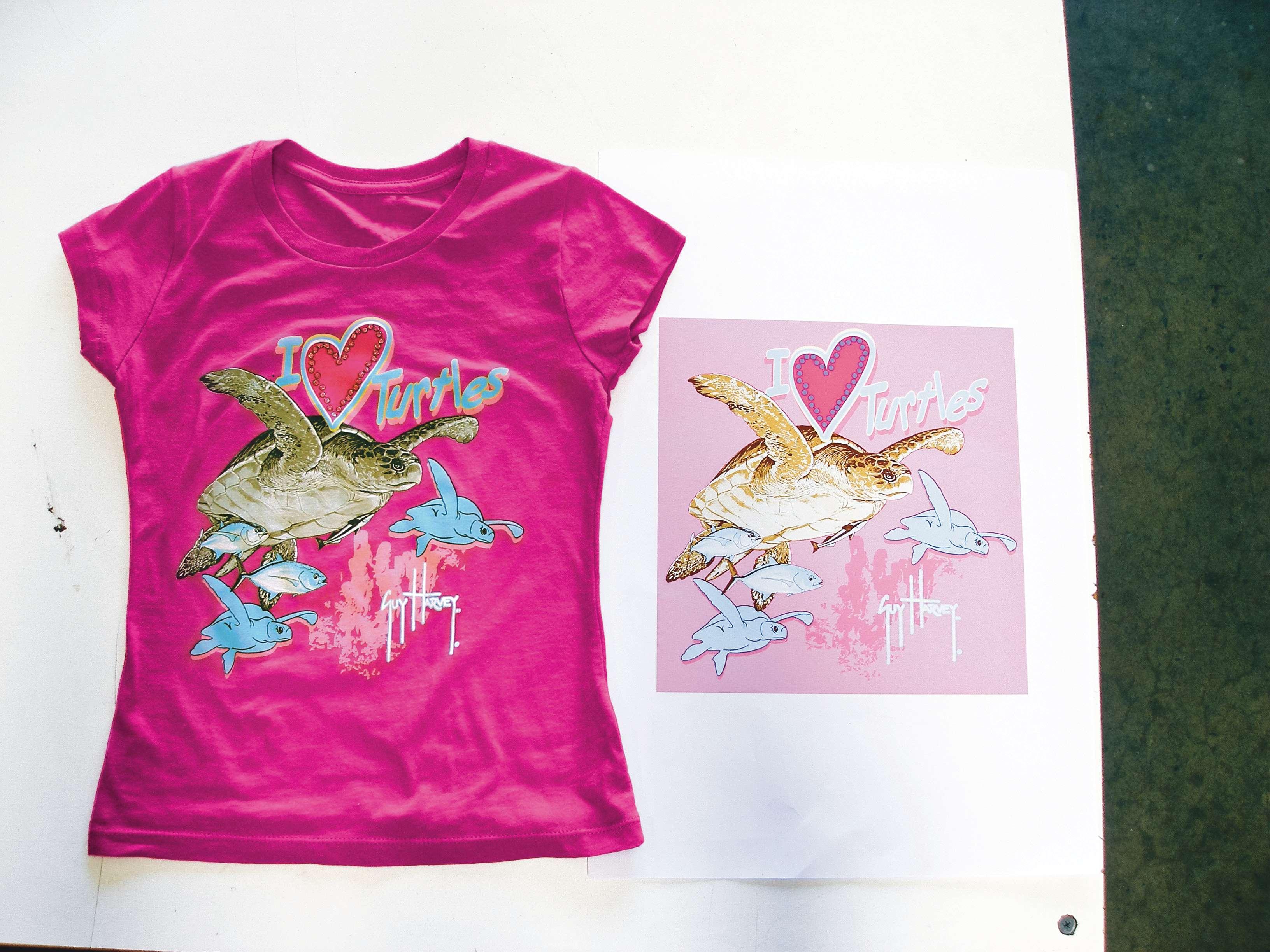
of coolness comes hard. With the best designs come top-of-theline screen printers, and AFTCO has tapped into the world’s top T-shirt printers. This is yet another reason the art on Guy Harvey T-shirts appears to jump off of the cotton. One of those standouts is Absolute Screenprint, run by locals Steve and Andrea Restivo. And this is no garage operation. Absolute is 60,000 square feet of raw T-shirt printing power.
As I walked around the warehouse among a hundred or so workers, I saw stacks of T-shirts for the likes of Lady Gaga, Justin Bieber, and Oakley. A half a dozen 14-color presses churned out shirts while Daniel and Simon waited to see how their designs would turn out.
I wanted to see the entire process from A to Z, staring with Anne and Terry scanning and modifying the original art, then moving to Daniel and Simon for further tweaking, and finally witnessing the printing process. Now the rubber was meeting the road and Daniel seemed as nervous as a husband waiting for his wife to give birth. That surprised me, considering AFTCO pumps out as many as 40 new designs a year. But Daniel was in mental lockdown mode with his antennae fully extended.
Steve Restivo himself was on hand to squeeze some ink. He clearly knows his way around the rubber paddle. The testing process is all manual: a man, a screen, a dab of ink, and a squeegee. Once they achieve precision and approve the colors, it moves to the automated press where they crank up the volume. Daniel and Simon nixed the first two shirts. The pink wasn’t right on one and some blues were off by a shade or two
americana
Like jazz, hamburgers, and gas-guzzling pickup trucks, T-shirts are part of Americana. First worn as an undergarment by Navy sailors, they soon became popular as daily attire in blazing hot, tropical climates. After World War II, tees were commonly worn by veterans with their uniform trousers. Then T-shirts rocketed into stardom in the early 1950s when Marlon Brando sported one in A Streetcar Named Desire and James Dean followed in Rebel Without a Cause.
Since then, they’ve been drenched in all-American culture—from hippie tie-dyes protesting the Establishment in the 1960s to the ubiquitous Hard Rock Café tees that proved the power of wearable advertising. Today, it’s almost as common for a company to have a T-shirt with their name emblazoned across it as it is to have a website and

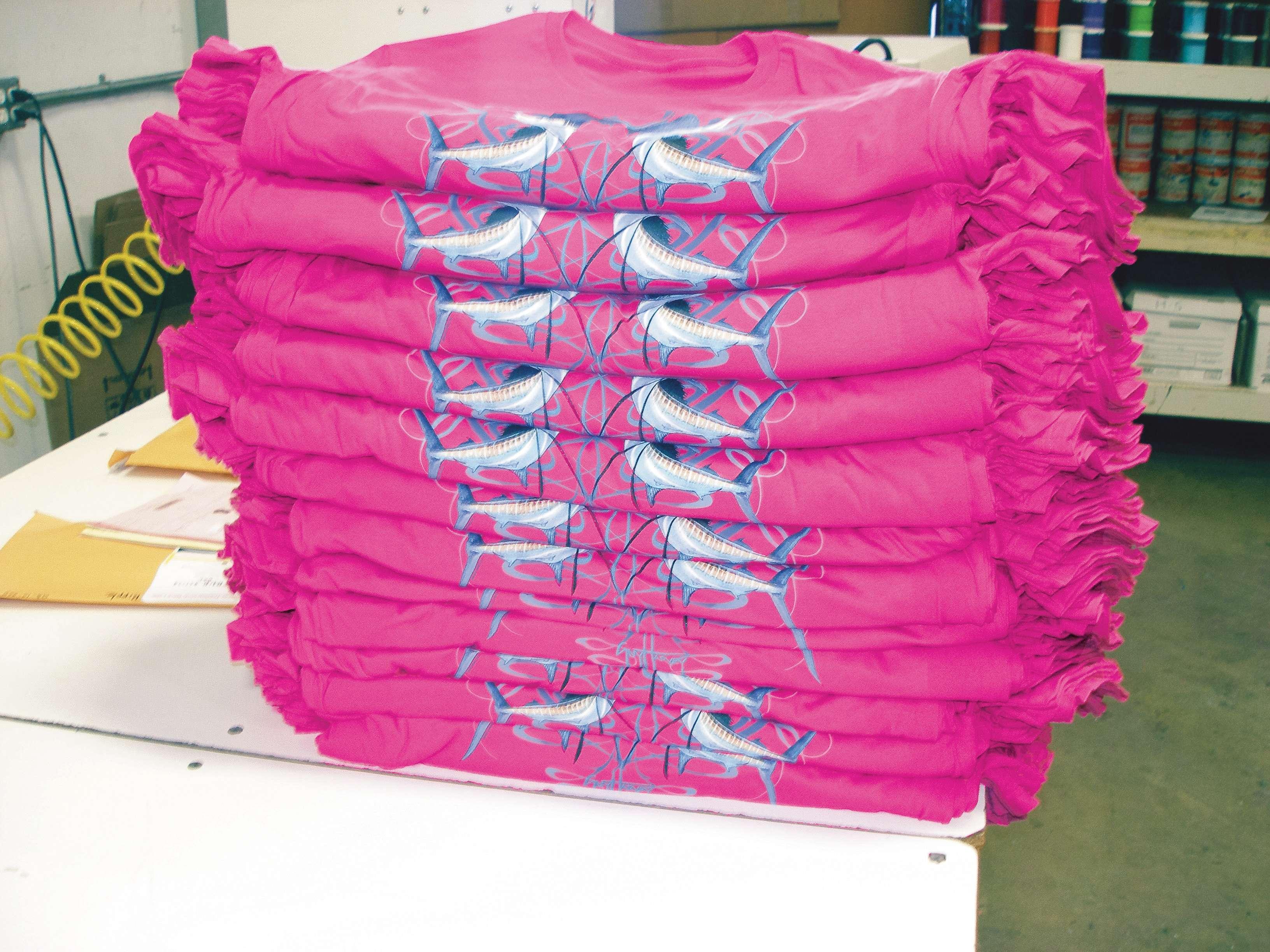

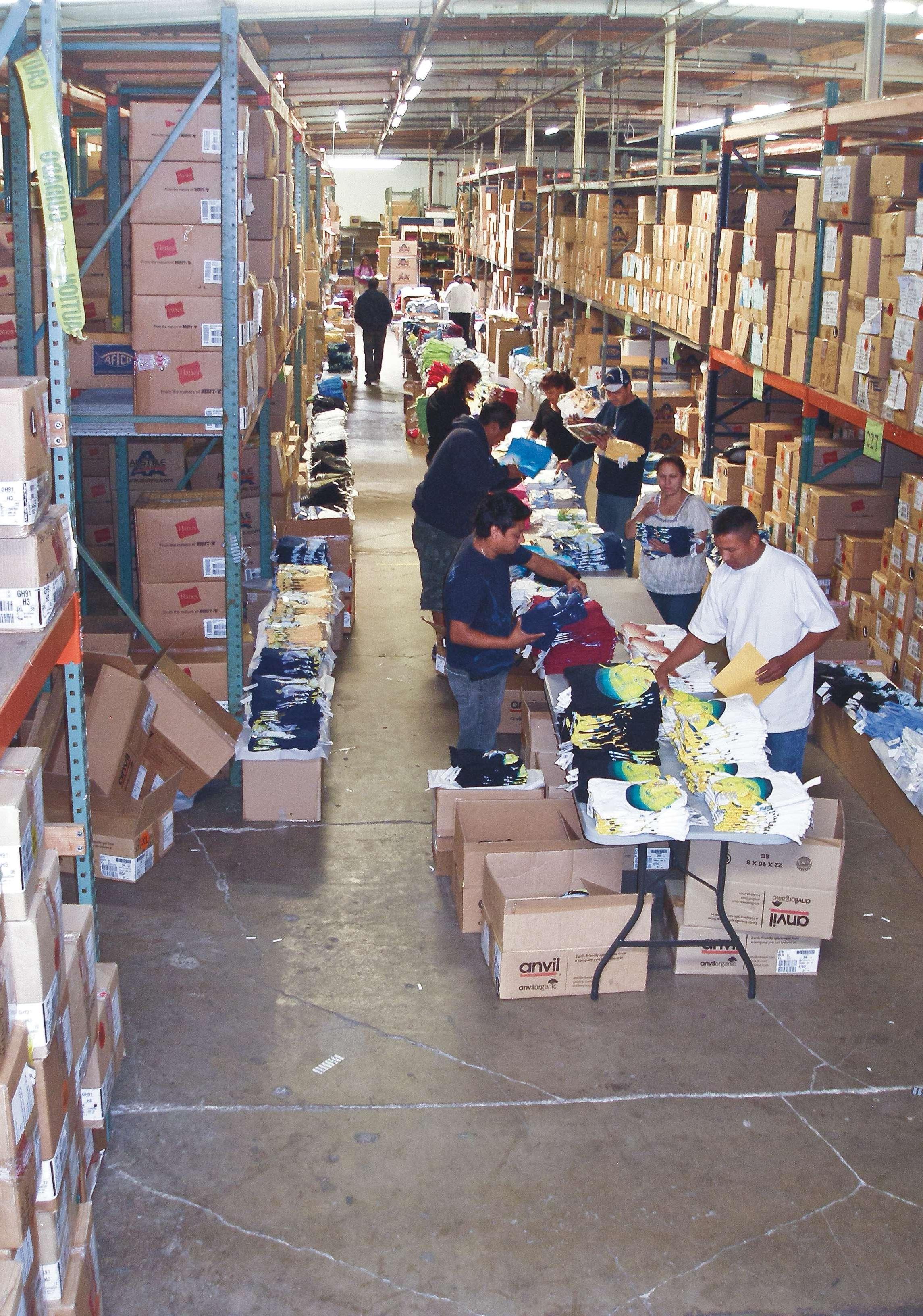




Dabs of ink wait their turn to grace a T-shirt (left). New product ready for the store shelves (center). Workers fill custom orders (right).

on the other. They pulled out the color wheel, made a few modifications, and ran shirts until they got it right. Finally, Daniel grinned.
Steve gave me the nickel tour of his facility, where they can do everything from creating original designs to attaching price tags to shirts. One of my concerns was the screen washing process where they clean the ink off the screens using various chemicals. It’s a concern of Steve’s, too. The entire washing system is self-contained with zero discharge and they use only citrus-based solvents rather than toxic chemicals.
“We recycle everything,” Steve said, “so there’s no waste. And when we replace the old liquids in the washer, it all goes to a certified treatment facility.”
In keeping with Guy Harvey’s conservation efforts, that was good news. telephone number.
For Guy Harvey, the transition from fine art to T-shirts was natural. Tees were part of the fisherman’s core wardrobe and his art was a badge of honor, especially for men chasing blue-water billfish.
The difference then and the difference now is that Guy Harvey isn’t into personal yachts and G5 jets. His passion is marine conservation. The sale of his T-shirts powers that commitment. In fact, it’s having a profound effect on our oceans because Guy’s voice has more reach than ever, now resonating in the halls of government. The movement toward more catch and release tournaments, circles hooks, shark-free marinas, and fishery research has been strongly influenced by Guy Harvey’s and Bill Shedd’s vision for healthier, more prolific oceans. It’s pretty amazing what a T-shirt can do.


Big game anglers know that Central America’s
Pacific coast is a hot-bed of activity. It sustains world record recreational catch rates and beckons anglers year after year to Guatemala, Costa Rica, and Panama for incredible billfish action. Of course, these diehards are not alone. Along with recreational boats, commercial longliners also know this stretch of ocean. The result has been a growing competition for a finite resource. For those concerned with the survival and long-term health of this important fishery, the central question has become just how finite the resource might be and what needs to be done to protect it. The value of the eastern Pacific’s billfish population is not hard to understand. Even setting aside intrinsic value to the natural world and focusing on raw economics yields a compelling argument for conservation. Research has shown that recreational fishing yields a much more potent economic impact per fish than commercial operations. A billfish, caught and released, generates anywhere from $800 to $2,500 in tourism revenue, while a billfish caught by a longliner and brought to shore for human consumption only nets $60 to $100. Despite such a strong economic incentive to promote catch-and-release fishing, there are few, if any, regional billfish management strategies in place, and local enforcement is simply non-existent.
Complicating these issues is the simple fact that billfish rarely stay put in one area. Their migratory nature means that even if regulations are in place in one locale, they are meaningless in the remainder of the billfish’s range. Therefore, a viable approach to protecting billfish must encompass an area larger than traditional management zones. The catch is defining the region. Part of this process is understanding why billfish move from one area to the next, and researchers have discovered a fascinating dynamic in the eastern Pacific.
Global fishing pressure on marine species has created changes to which entire ecosystems are forced to adapt. Crosscontinental winds in this part of the Pacific force deep oxygen-poor water toward the surface, effectively compressing the viable fish habitat into the upper layers of the ocean (Fig. 1). As a result, large areas of the open ocean are stratified, allowing marlin and sailfish to feed on concentrations of prey at different times of the year. Understanding how predator and prey species adapt to seasonal and natural changes in their habitat is critical for successful management. And the stakes are high.
There has been an 86% decrease in sailfish abundance and a corresponding 42% decrease in trophy size (Fig. 2) in the eastern tropical Pacific Ocean. Even more than those numbers is the fact that local governments have not reacted with any conservation programs to protect these valuable fish. Currently, the average number of sailfish caught in daily sport fishing trips in Guatemala and Costa Rica differ dramatically (Fig. 1). The difference in catch rates between the two nations is the result of a greater number of commercial fishing operations carried out by coastal longliners in Costa Rica than in Guatemala and has Costa Rican sportfishing operators understandably concerned. In the meantime, catches per trip are historically sustained in Guatemala except during strong El Niño years when seasonal habitat compression along the
Central American region does not fully develop due to weakening winds. Each of these dynamics—billfish migration, seasonal habitat changes, commercial and recreational fishing pressure—adds a new layer of complexity to effectively studying and managing billfish in the eastern Pacific. It all adds up to a pressing need for what researchers call ecosystem-
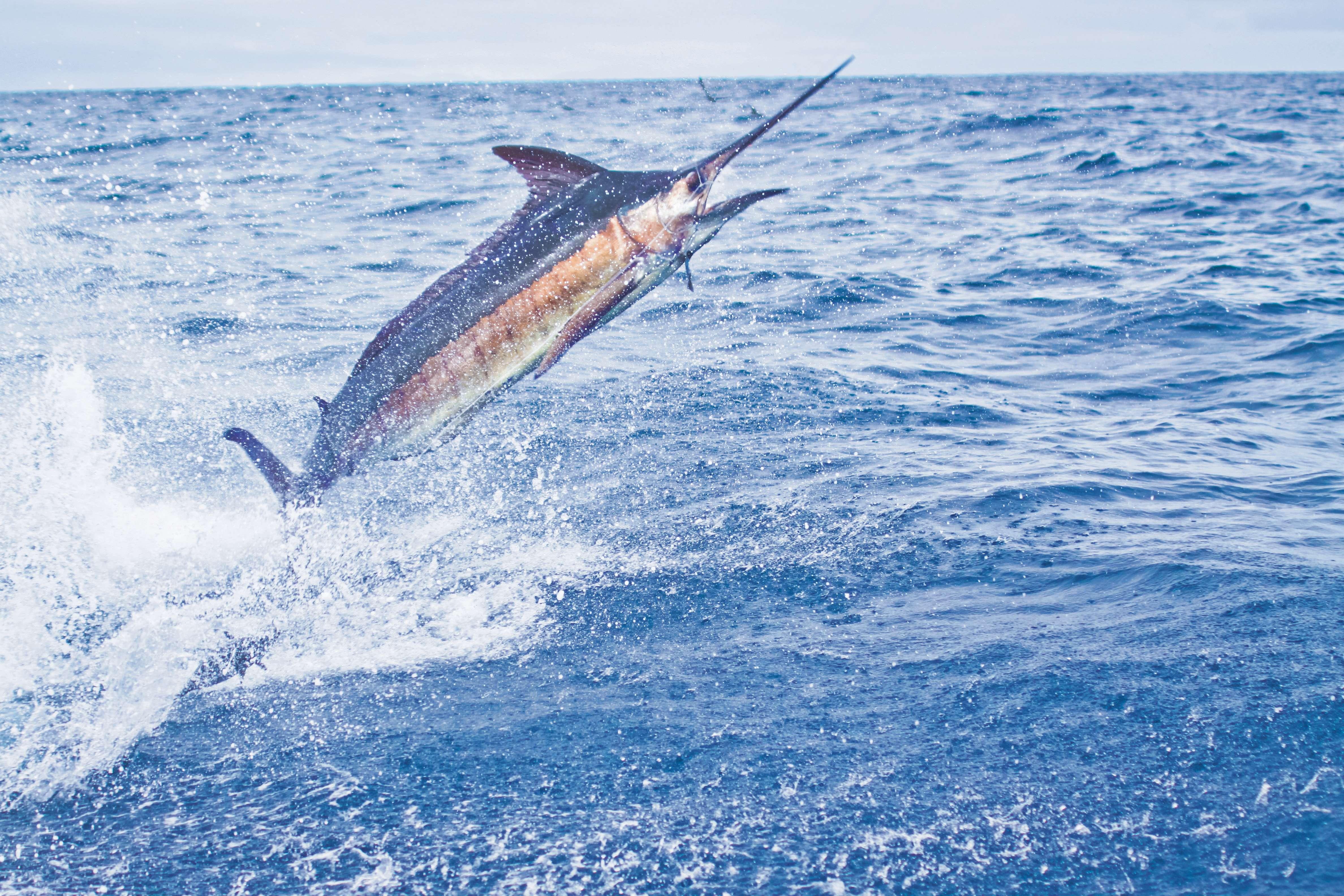









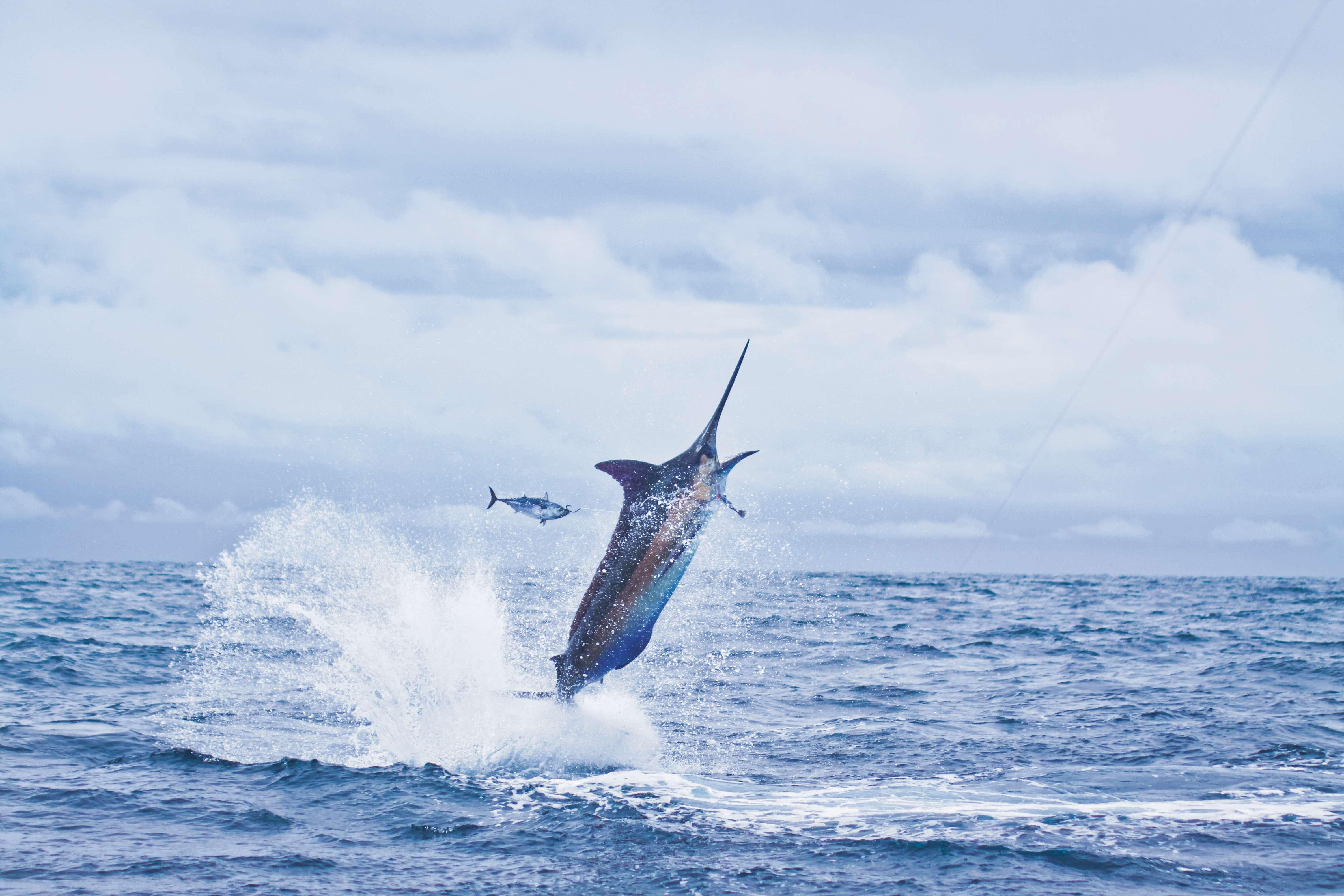





based management (EBM) strategies. To tackle the issue, the Central American Billfish Association (CABA) based in Miami, Florida, has joined the University of Miami Billfish Science Research Initiative in studying the region. What’s exciting about this partnership is the use of a brand new, integrated, and high-tech approach to data collection. It includes three components: a satellite logbook system to help assess overall billfish populations, a satellite tagging program to track billfish migrations, and a hydroacoustic monitoring program to track prey species billfish used for food.
Technology To The Rescue
The first step was to develop and deploy a satellite logbook system that collects sportfishing catch data on a real-time basis. This system effectively uses recreational anglers and boat crews to be the eyes of researchers every time they’re on the water. The system allows them to log location and time-stamped encounters with billfish and with other important species such as tunas and mahi-mahi, as well as observation of dolphins and longline gear encountered at sea.
The system uses a waterproof Smartphone device with a touch screen. This links wirelessly to a satellite antenna via Bluetooth (Fig. 3). This unique satellite antenna immediately sends out real-time information on the location of the vessel and billfish encounters to a server at the University of Miami. The handheld device allows the boat crew to move freely throughout the vessel and log any encounter, and record specific characterizations such as caught-and-released fish, bites, and raises (fish visually seen around a sport vessel). The crew can also record types of fishing gear used, such as fly, bait, or lure.
This highly detailed and real-time information gives researchers exactly what they need to determine the relative abundance and distribution of billfish. They can also compare this data with known ocean conditions taken from other satellite sources: things like temperature, sea level, ocean currents and fronts, chlorophyll production, and dissolved oxygen. This kind of integrated information approach has never before been used in the monitoring, assessment, or forecasting of any fishery— let alone billfish.
The second element in this research project is a satellite tagging component that will give scientists specific information about billfish behavior, travel patterns, and habitat use. Cutting-edge technological advances by satellite tag developer and manufacturer Desert Star Systems have made these tags far more affordable than in the recent past. Instead of nearly $4,000 per tag, researchers are spending about $1,500 for each unit, greatly increasing the amount of data that can be collected. These new Desert Star Systems tags also log fish movements in time and space with far higher precision than traditional satellite tag models. Using technology employed by the U.S. Navy submarines, the tags use the earth’s geomagnetic gradients to determine a fish’s location rather than using extrapolations based on light levels and the earth’s inclination.
Once a tag releases from a fish and reaches the surface, it uploads recorded data via satellite to the research team. Using solar energy to recharge its batteries, the tags have a lifespan of a full year. Enhanced battery power and an extremely large storage capability allow the new tags to record variables of location, temperature, depth, acceleration, and angular velocities of the animal. Being able to record the acceleration of billfish is a unique concept that can help reveal feeding and reproductive behaviors in time and space and with respect to ocean conditions. Furthermore, these tags have the capability to record ambient oxygen levels, which is likely a key factor in how these animals are distributed in the three-dimensional, oxygen-deprived, eastern Pacific Ocean.
The third and final component of the project consists of scientific hydroacoustic surveys to map the location and abundance of the billfish food supply. Specifically, this soundwave-based technology helps researchers understand the seasonal shifts of the abundance and distribution of the billfish prey species that attract these apex predators to the Central American region. With the assistance of digital, real-time oceanographic maps, and information from the aforementioned projects, the investigators select specific areas of the ocean where prey species are most likely found. When the data is collected and combined with information gained from satellite logbooks and satellite tags, it paints a highly detailed picture of billfish habitat, movements, food supply, feeding, and even spawning behaviors.
The unique skills and technology that have come together in this CABA/University of Miami team is providing the researchers and fishery managers with the information they need for effective conservation measures. And the best news is, it’s just the beginning. NOAA recently granted a multi-year population dynamics fellowship to one graduate student to specialize in billfish population dynamics while a second PhD student has been recruited with CABA funds for the same purpose. With these educational efforts, the University of Miami Billfish Science Research Initiative looks to not only move forward with conservation measures, but to develop a new group of scientists responsible for preserving these fish and their ocean in the future.

The C AB A/UM research team is open to cooperative efforts with other research institutions and individuals interested in advancing knowledge of billfish in the eastern tropical Pacific Ocean. Anyone interested in further information and collaboration can contact the University of Miami Billfish Science Research Initiative, Dr. Nelson Ehrhardt (nehrhardt@rsmas.miami.edu) at the Rosenstiel School of Marine and Atmospheric Science. Ph: (305) 421-4741.

F i s h i n g F o r W i n n i n g s i n
A curious, AquAtic vibe is Alive And well in
V e g a s the desert BY Fred GArth

I first rolled through Las Vegas in 1976 when the food was cheap, blackjack was $2 a hand, and The Strip consisted of a smattering of moderately cheesy hotels. I was just a college kid from Alabama in a beat up Chevy and barely enough money to spring for the $2.99 prime rib dinners they used to lure in impressionable wayfarers. It worked. This past July, the International Convention of Allied Sportfishing Trades (ICAST) hosted its annual trade show in Vegas and, I must point something out here, the town has changed just a wee bit. I booked a room at the Mandalay Bay Resort & Casino and felt like Jed Clampett stumbling into Beverly Hills. The Mandalay Bay complex houses 26 restaurants, a humongous cement pond with an authentic sandy beach, a 1.6 million gallon aquarium, a lazy river, a ritzy shopping mall, and a private “toptional” pool area. Oh yeah, there’s a casino, too. When I first came to Sin City, the fountains at Caesar’s Place were considered an attraction. Crowds of gawkers gathered to watch. Now, the waterspouts have been trumped by a plethora of amazing ostentatiousness from the faux Italian village at the Venetian to replicas of the Eiffel Tower, the Statue of Liberty, the Sphinx, and New York’s skyline. Where else can you get Egypt, Venice, Paris, and the Big Apple within a few city blocks? Only in Vegas, my friend. Add to that a few tongueswallowing roller coasters, a zip line that runs over the top of Main Street, an elaborate network of monorails, escalators, pedestrian overpasses, and an army of taxis, buses, limos, and water gondolas, and you’ve just begun to scratch the surface. Do I miss the Vegas of old? Well, I’ve always been a sucker for cheap meat, but the truth is, Vegas has become even more of a grandiose destination, a glittering carnival of eye candy, and home to some of the planet’s most fantastical shows and delectable restaurants. They’ve grown up from
Wayne Newton’s crooning and Don Rickles’ insults to full on Cirque de Soleil extravaganzas, a spectacular theatrical production of The Lion King, and the world’s best acts from U2 to Blue Man Group. And, finally, the City of Flashing Lights is the undisputed champion of the consumer and trade show universe. Every convention worth its feather boa eventually lands in Vegas. I find this both weird and comical because the world’s glitziest town is the last place you want to be working. It has perfected every possible distraction from hard labor known to man. It tugs you in every direction except toward your paying job. This is a place that teases and tempts even the most moral and diligent humans. It’s where you don’t want to keep your business cards handy. Or, perhaps the distractions make Vegas the perfect place to host a convention and I’m still just a naïve kid from the Deep South longing for a cheap meal. Unless you elect to move there or spend a month or so on a perpetual tour, there’s no way to experience all of Las Vegas in a single stay. You just have to pick and choose which shows, restaurants, and attractions you want to take in and where you prefer losing money. Since Guy Harvey Magazine has everything to do with water and marine conservation, I focused on that genre, starting with the world’s biggest fishing show.

Above: Bird’s eye view of the show floor. Below: Fishing machines: the Hobie and Diablo kayaks.
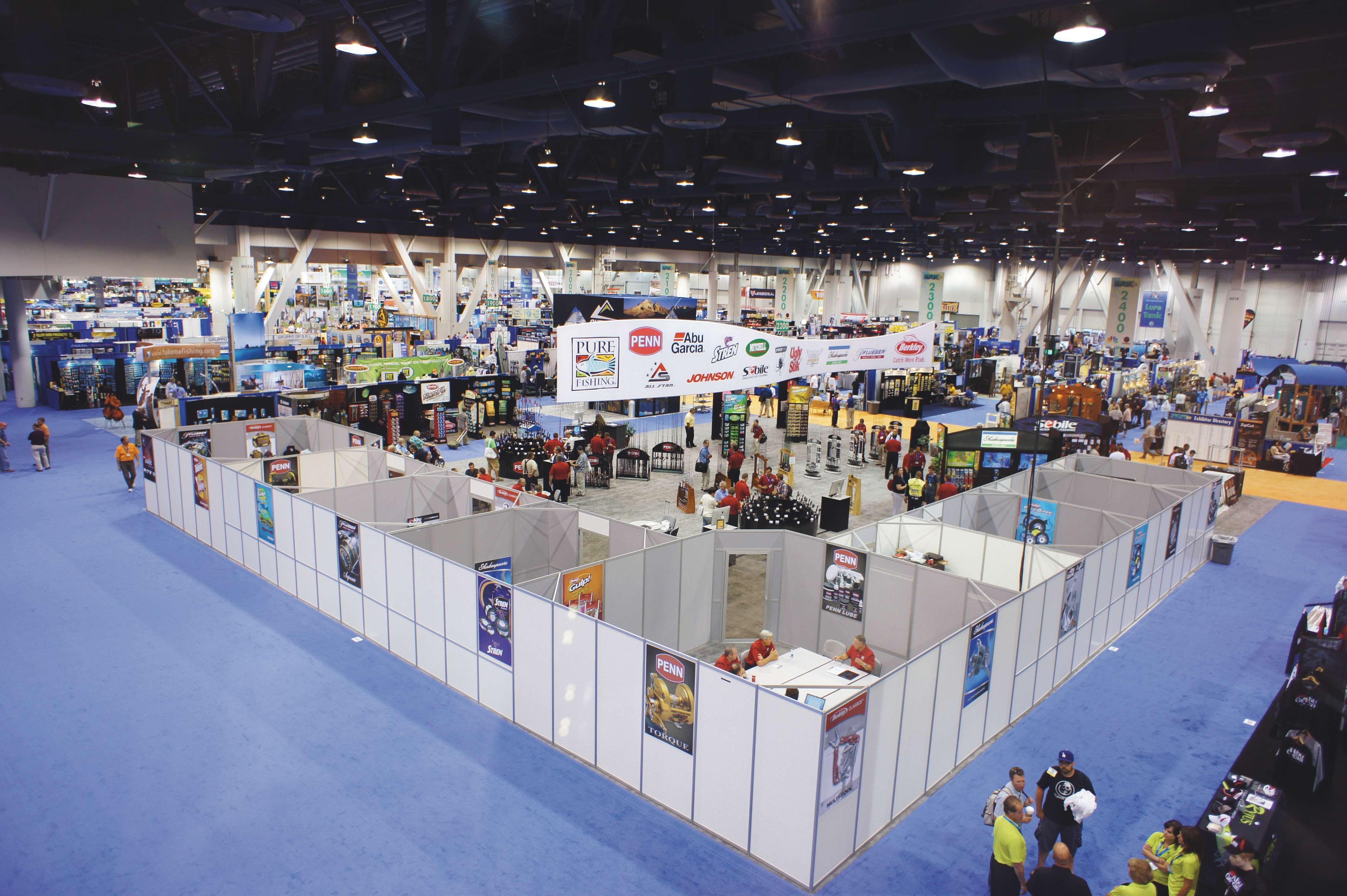

ICAST
The first thing I realized when I strolled around the show floor was how many companies make fishing lures. I guess it makes sense, but this being my first ICAST, it just never occurred to me. Sure, you have your big guys like Rapala and Yo-Zuri but there are a boat-load of mom and pop lure makers showing their wares.
ICAST also tilts a bit toward the freshwater fisherman. Big saltwater names like Penn and Shimano were well represented, but there were also tons of lake and river folks who know more about bass and muskie than tuna and marlin. Not that there’s anything wrong with that. The American Sportfishing Association sponsors the event and claims to be moving more into the saltwater realm. Sounds good to me. And I noticed a few other media companies that key in on the salt life.
Kayaks were also quite prevalent and, as we all know, kayak fishing is booming. Hobie is a big dog in the hunt but I also liked the Diablo built out of Texas. Speaking of kayaks, one of my favorite companies, Torqeedo, was also on hand with their nifty electric outboard engines. Torqeedo has a compact unit that retrofits on kayaks and can push them along as far as 20 miles on a single charge. But they also have an outboard that is equivalent to a 10 horsepower that is causing some waves among the gasoline burners. I’m still working on my ultimate green boat with quad Torqeedos and solar panels to run the whole machine.
Overall ICAST was incredibly impressive. It’s a trade show so it’s generally not open to the public. But if you ever get a chance to represent a fishing company, it’s worth a walk about. ICAST 2012 is in Orlando.



Chef Moonen. Cioppino – a favorite at rm seafood. The downstairs restaurant.
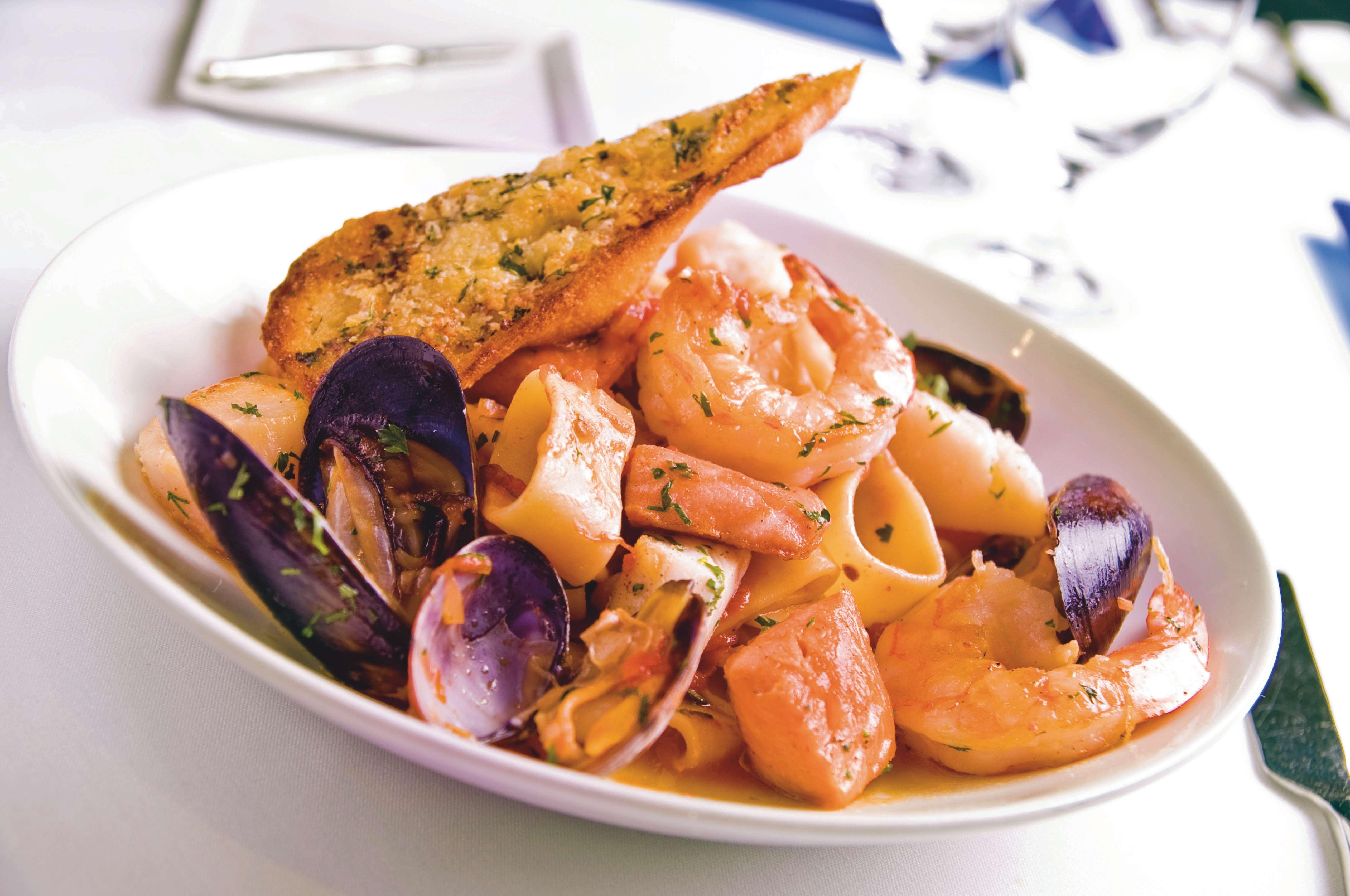

rm seafood
Of the more than two dozen restaurants in the Mandalay Bay Resort & Casino, only one serves 100% sustainable seafood. Not that the others are bad—I liked all that I sampled and I even enjoyed the cuisine at the House of Blues twice. Despite my skepticism, authentic jambalaya is easy to find in Vegas. And fortunately, so is responsible seafood. In fact, Chef Rick Moonen, owner of rm seafood in the MB Resort, is one of the planet’s most respected sustainable seafood chefs and is a recognized expert in the field. Moonen works with leading authorities such as the Monterey Bay Aquarium and has been on numerous television programs (including Iron Chef) touting the virtues of eating seafood that does not deplete or damage our marine resources.
As the ever-diligent journalist, I tracked Chef Rick down at his restaurant to ask him a few questions.
GHM: Is it harder or easier to find sustainable seafood than it used to be? RM: It’s about the same. I’ve been doing this for a long time and we’ve been serving sustainable seafood here since we opened the restaurant eight years ago. It’s something you really have to stay on top of because some species have come back and others are coming under more pressure.
GHM: What is the genesis of your commitment to sustainable seafood? RM: Well, mainly because it’s the right thing to do for the planet. And, we don’t have to compromise quality. The customer still gets a healthy, delicious meal. We have some incredible shellfish—clams, oysters, mussels, and scallops—some from the East and West Coasts and also the Gulf of Mexico that are all sustainable. Wild caught salmon, halibut, lobster, king crab, Dungeness crab—all incredibly delicious and all sustainable.
GHM: You mentioned the Gulf of Mexico. Did the oil spill affect what you buy? RM: After the spill, we just didn’t know what to expect and I think the future is still uncertain. But from all indications, the Gulf has come through really well. It is a massive body of water with a tremendous flow and an amazing amount of nutrients. That’s why it has always been such an incredible fishery.
GHM: You visited Destin, Florida, along the Gulf Coast recently. How did that go? RM: It was impressive. The commercial fishermen, for the most part, are acting responsibly and seem to have a genuine concern for the resource. There’s such an abundance of great seafood in the Gulf— red snapper, cobia, grouper, tuna—and it’s imperative that those fish stocks are managed in a sustainable way. I’m optimistic because the stakeholders down there are very engaged in the process. Plus, there’s a tremendous amount of aquaculture developing in that region, so I believe the future for the Gulf is very promising.
GHM: Do you think aquaculture is the answer to our seafood needs in the future? RM: It’s absolutely a huge part of the equation. Right now, around half the seafood we consume is farmed, and that number is growing. We can actually get farm-grown caviar and game fish like pompano and cobia. It’s not just catfish and tilapia anymore. And the real beauty is that you don’t even need to be near the ocean. A new company, Blue Oasis Pure Shrimp Farm, just north of Las Vegas, has just started producing farmed shrimp. Years ago, we would have never thought of growing shrimp in the desert, but these guys are doing it very successfully, and they recycle their water and their waste so it’s all done in a very responsible way. For us, it means we can buy local shrimp that we might have imported from another country before.
GHM: What’s the future of sustainable seafood? RM: I believe the future is very bright. Certainly, we have some major issues like longlining and some of the big commercial fishing fleets, but there are a lot of bright, hard-working people focused on sustainable seafood issues. We’ve made great strides on many fronts and I believe we’ll continue to have more and more sustainable seafood choices.
One of Shark Reef ’s two walk-through tunnels.

the feast
My visit with Chef Rick would not have been complete until I sampled the fine cuisine. That’s the kind of hard-hitting journalist I am. Anything for the story. That evening I returned with a healthy appetite and a gorgeous blonde. Yep, fairhaired beauties are in abundance in Vegas. Of course, this hot blonde is also my wife.
While my honey feasted on sustainable sushi, I went big and ordered the Pacific halibut with scallops and clams. Ou la la! We topped our meal off with a perfectly chilled Pinot Gris from France and some sparkling water from Italy. Tres bien! As I mentioned earlier, I was introduced to Vegas in the ‘70s with all-you-caneat buffets (they still have those) and cheap steak (not so much). Sitting in rm seafood, dining on fine cuisine that is also sustainable, was an experience I can only describe as fantastique. For some reason I speak French when I eat fabulous food.
The restaurant is outfitted with lots of stainless steel and the staff was friendly and warm. In fact, our server, David Silva, offered the perfect blend of prompt, yet non-intrusive, service and catered to our every need. Many thanks to Chef Rick and his staff for creating a gorgeous and modern restaurant that serves sustainable seafood that is also délicieux!
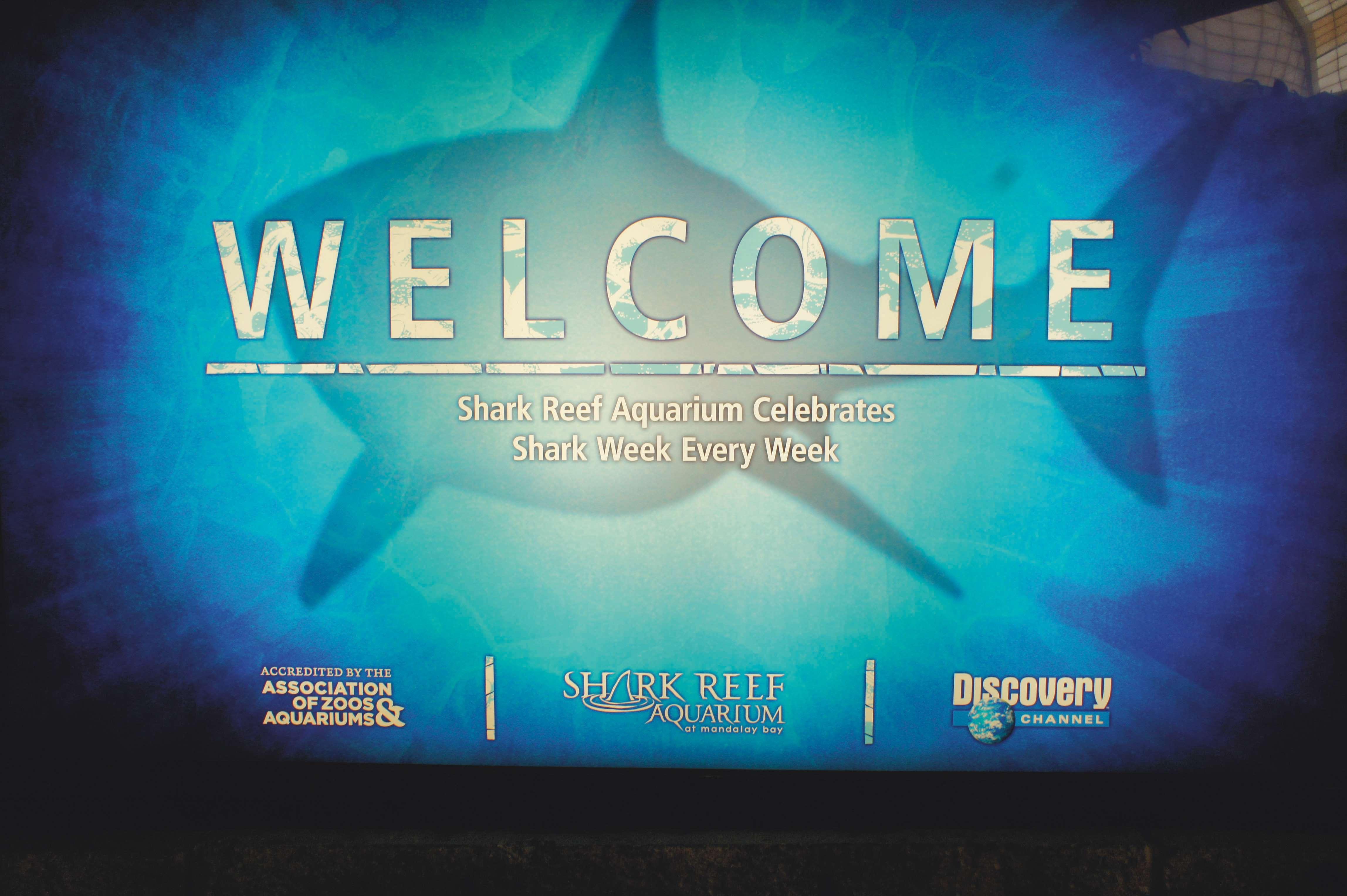
shark reef
In addition to rm seafood, one of the main reasons we booked at the Mandalay Bay was because of its world of water. In addition to the fab pools at the resort, they have Shark Reef, a 1.6 million gallon aquarium. I’ve toured a bunch of aquariums, from San Diego to New Orleans, and have even been scuba diving in The Living Seas, Epcot’s 5.7 million gallon aquarium. Shark Reef may not be as huge as some aquariums, but given Guy Harvey’s monumental efforts to save sharks from being annihilated across the planet, it’s great to see an aquarium focused on the ocean’s apex predator. It’s also very wellconceived. Not only are the displays intriguing, the walk-in shipwreck surrounded by the big shark tank is super cool. However, one of the most impressive aspects is the educational and conservation focus at Shark Reef. Backlit displays highlighted key facts about sharks from their plight in the shark fin trade to what sharks like to eat (hint: it’s not people). It’s almost as if Guy Harvey himself consulted with the creators.
In all, Shark Reef has more than 2,000 animals including piranha, jellyfish, a rare golden crocodile, and an impressive collection of lionfish. Once inside, you forget you’re surrounded by desert, and it’s easy to meld into the cool blueness of the undersea world. The main shark tank has toothy sand tiger
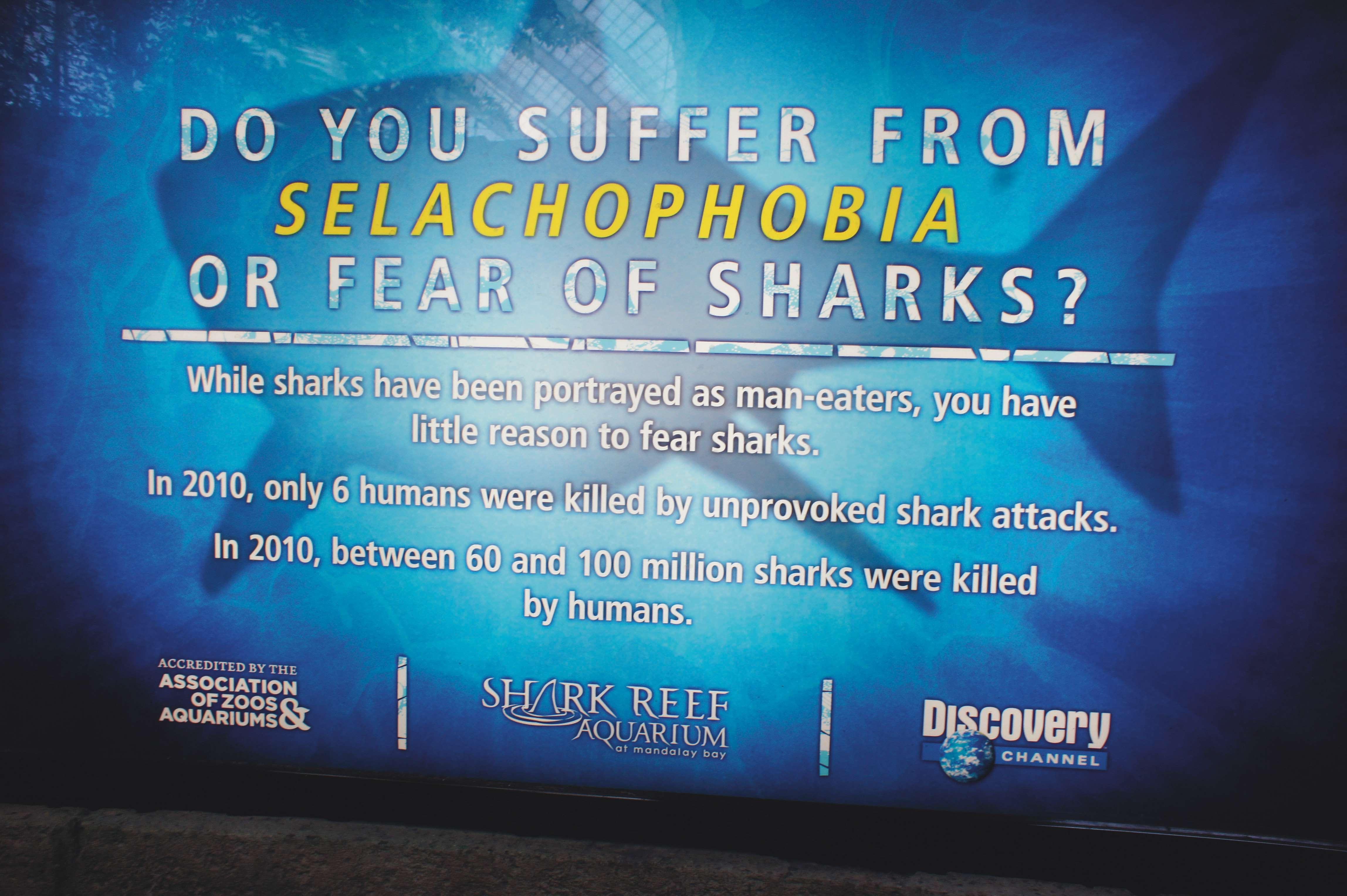

Education is a big part of the Shark Reef experience.
sharks, sawfish, reef sharks, and a nice variety of rays. It’s also available to MB guests who want to scuba dive in the 22-foot-deep shark tank. The price tag is a bit high ($650), but it’s a three-hour event and a chance to mingle with sharks who are not interested in winning your money. Overall, the aquarium has 100 sharks encompassing 14 species. There are two awesome walk-through tunnels giving a diver’s view without getting wet. The admission of $18 for adults and $12 for kids is well worth it, especially when you compare it to other Vegas attractions. Can you say $150 for zip lining?
Le RÊve
One absolute highlight of a Vegas holiday is going to a big show. Some of the city’s highest rated are the Cirque de Soleil shows including The Beatles and the iconic O that has been playing for more than a decade. O is famous for its water elements and I was amazed when I saw it back in 2001. I wouldn’t have minded a repeat performance. However, we were steered by Sally Oyer, Vegas concierge extraordinaire, to see Le Rêve (French for “The Dream”), another water-intensive show, at the Winn Resort. Simply put, it was mind blowing. It’s not a Cirque show but it’s very much Cirque-esque. The performers are amazing, the costumes are wild, and the round theater doesn’t have a bad seat in the house. The pool in the middle is sometimes a stage for the actors/acrobats to perform incredible antics and sometimes a deep enough pond for them to plummet 70 feet from the domed ceiling and plunge into the roiling waters. Tickets are fairly affordable (as low as $120 each) and if you go, prepare to laugh while also being amazed.
TRaveL Tip
Even if you’ve been to Vegas and know your way around, using a concierge service is a good idea. These are real people who know the town, what’s hot, and what’s not. Many of them don’t charge a fee and can get discounts on show tickets, restaurants, and attractions, as well as coupons galore. They make their money on commissions from the places they book for visitors so, as they love to say in Vegas, “everybody wins.”
The cool pool at Le Rêve.
DeaL in The DeseRT
While the Vegas experience can be extraordinary, I wouldn’t say that this town is a beacon of conservation. When they talk green, they’re referring to cash money. However, it’s amazing that the marine conservation message is permeating our culture so effectively that it’s reached a place that sucks down megawatts like predators feeding on a bait ball. Shark aquariums, sustainable seafood, farmed shrimp, and who-knows-what’s-next are making a new kind of green imprint in the desert.
Also a big shout out for Rosalind Terlitzky, Melissa Eichelberger, David Silva, Ken Langdon, David Gonzalez, and Ashley Farkas for their assistance in making my rm seafood/Mandalay Bay experience one of the best ever.
paSS tHe BIllFISH BIll
by capt. dave lear
Unless you’ve spent your summer vacation chillin’ in Antarctica, you’ve been inundated with news about the current political climate in Washington. Democrats are pointing fingers at Republicans and vice versa. The president is walking a tight rope and the Tea Partiers are stirring the pot. Poll numbers for politicos are about as low as a limbo pole at a drunken beach party. Yet, in spite of all this rancor, there is at least one ray of bi-partisan hope—the Billfish Conservation Act of 2011.
Introduced by Senator David Vitter (R-LA) and Congressman Jeff Miller (R-FL) with 11 co-sponsors from both sides of the aisle, this important piece of legislation would significantly help restore declining numbers of billfish. If passed, the law would prohibit the sale of all billfish (marlin, sailfish, and spearfish) in the United States. It would still allow for traditional fisheries within Hawaii and the Pacific Insular area. Swordfish would not be included in the ban.
“Several billfish species are in serious decline according to a recent global assessment by the International Union for the Conservation of Nature,” says Rob Kramer, president of the International Game Fish Association and a proponent of the bill. “This is a wonderful step by Congress to recover billfish and create new jobs in the sportfishing and marine economy.” The IUCN assessment concluded that blue and white marlin are now threatened, and striped marlin is nearly threatened with extinction.
Regarded as royalty among the marine species, billfish are apex predators that play a crucial role in maintaining a healthy ocean ecosystem. They are the ultimate catch for recreational anglers, with a healthy release the overwhelming result. The sport creates thousands of jobs in the marine industry and generates billions of dollars to the U.S. economy. In developing nations like Costa Rica, Panama, and Guatemala, this renewable resource is a major portion of each country’s gross national product. The trickle-down impact on local jobs and economies is huge. So passage of the law would have repercussions far beyond our own borders.
Billfish are primarily taken as by-catch in non-U.S. commercial tuna and swordfish fisheries. The by-catch is harvested and sold internationally, with the United States as the largest importer. For nearly two decades, the U.S. has had a ban on the sale of Atlantic-caught billfish. But the same protection doesn’t extend to those harvested in the Pacific. This loophole creates a blatant black market for the protected Atlantic species, since enforcement is nearly impossible. A ban would have little impact on the commercial fishing industry. Billfish account for just 0.07 percent of the total annual revenue from commercial harvest in the United States. Besides, there are numerous sustainable—and better tasting—alternatives for restaurants and retailers to offer instead of billfish. In fact, based on ethical sensibility, a long-running PR campaign (“No Marlin on the Menu”), and sporadic supplies, most responsible establishments have already quit selling billfish. “The Billfish Conservation Act of 2011 makes it clear that the future of billfish is not for sale,” says Ken Hinman, president of the National Coalition of Marine Conservation, another group supporting the bill. “Hats off to Congressman Jeff Miller, Senator David Vitter, and the bi-partisan co-sponsors of this legislation for making sure there will always be plenty of billfish in the sea, for this and future generations of anglers.”
Still, passage is not guaranteed. Nothing in Washington ever is. That’s why all of us citizens need to pick up the phone or start banging out those emails. Urge your senators and representatives to support the Billfish Conservation Act of 2011.
Do it for the fish! Do it for the jobs and the economy. Do it because Congress needs all the positive vibes it can muster.
Let’s get ’er done.

tHe compleat angler
Not much stands up to the test of time. Americans live in the same house an average of only seven years. When a television fritzes out, we buy a new one. We change cell phones more often than underwear, and most of us have a graveyard of old fishing reels, poles, and lures that are more likely to rust than get repaired.
So in our throw-away society, it’s amazing, especially in this age of iPads and digital publishing, that a book about fishing has stood the test of time. Of course, calling The Compleat Angler a fishing book is like calling the

Image Courtesy J.N. Bartfield Galleries, New York City Constitution an old piece of paper. Written by Izaak Walton in England in the 1600s, The Compleat Angler is THE fishing book. It’s the quintessential volume on the subject.
For this reason, we’ve named our new fishing-only section in Guy Harvey Magazine after the world’s most respected fishing book (with an updated spelling, of course). Our goal is to represent the name with respect and do it justice. Not that it needs more notoriety. Walton and The Compleat Angler’s fame is already steeped in our history. His name has popped up in

by GHM StaFF
books written by Charles Dickens, Jules Verne, Washington Irving, and many more. There was once a resort in Bimini called The Compleat Angler where Hemingway frequented and there is still a hotel on the River Thames in England called Macdonald Compleat Angler Hotel (nothing to do with Big Macs). The name is simply legendary.
Even though the first edition of Walton’s book was published Izaak Walton
358 years ago in 1653, many of his statements are as true now as the day they were written. Here are a few of our favorites:
“Angling may be said to be so like the mathematics that it can never be fully learnt.”
“As no man is born an artist, so no man is born an angler.”
“And for winter fly-fishing it is as useful as an almanac out of date.”
“Angling is an art worthy the knowledge and patience of a wise man.”
“You will find angling to be like the virtue of humility, which has a calmness of spirit and a world of other blessings attending upon it.”
“No man can lose what he never had.”
“We may say of angling as Dr. Boteler said of strawberries: ‘Doubtless God could have made a better berry, but doubtless God never did;’ and so, (if I might be judge,) God never did make a more calm, quiet, innocent recreation than angling.”
side from the quaint village of Oriental, there’s nothing particularly romantic about North Carolina’s Neuse River. The brackish water and surrounding marsh isn’t exactly the ideal setting for a romance novel. The beach is not easily accessible for moonlit walks. And the odds of finding a pair of bathtubs from a Cialis commercial are about a billion to one. Yet every year, from August until early fall, these fertile waters are the scene of one giant love fest. Big bull redfish gather here to spawn, and the ritual not only provides a special sportfishing opportunity, it’s also a showcase for good fisheries management.
“This is really a great success story,” Capt. George Beckwith told me as he anchored his 23 Parker center console last September in the middle of the broad river basin. “When I first started guiding in 1994, we only caught the little bitty guys and the great big fish. There was a missing link of young adults. But now we’re regularly catching those fish that are spawning for the first time and that’s great to see. North Carolina has finally done it right by protecting these future generations.”
Beckwith makes that statement with obvious pride. Besides running his successful guide business, he is married to Anna Beckwith, who is an at-large member of the North Carolina Marine Fisheries Commission. The two met when she was doing her graduate work in Biologic Oceanography at North Carolina State University. She joined us on the boat and gave me the background on this unique fishery.
“Starting in August, these fish spawn on the full and new moons,” she explained. “One female can potentially spawn 10 to 20 times per season. The males attract females by drumming, and release milt when they match up, so that’s a lot of eggs being fertilized. We’re now seeing a huge amount of young adults in the 30- to 40-inch range. The regulations that are in effect are working and these fish are now making it to adulthood.” The bag limit for redfish in North Carolina is one fish, 18 to 27 inches, per person.
“The Neuse River is 28 parts per million salt to fresh, so it’s a brackish estuary,” George added. “This is really the factory for North Carolina’s redfish. The juveniles will stay inside for three to four years until they grow to more than 30 inches, then they’ll move offshore. If the full moon is late in September, they’ll bug out right after that. I tagged a 30-inch fish a couple years ago and it traveled from the river through the ICW to Morehead City. It made 24 miles in 14 days before it was recaptured. By October, the big fish will be out along the Outer Banks.”
The Neuse River has very little current, so Beckwith depends on the wind to move water and the fish. He anchors near shoals, starts chumming, and lets the fish come to him. There are times, however, when the reds will corral

menhaden on the surface, frothing the water white while feeding. During those conditions, it’s possible to cast bucktail jigs into the melee. Beckwith has also witnessed times where the big bulls will chase small flounder to the top where they’ll skip like Frisbees in an attempt to escape. The reds will also lay up in very calm water on top of shallow bars, barely moving with dorsal fins or tails exposed, which requires a stealthy approach. But the anchor-and-chum method is the most productive, by far.
“It ain’t pretty fishing, but it works,” he says. “The bigger fish will be in deeper water.”
Beckwith’s typical arsenal is 20-pound class spinning rods loaded with 300 yards of monofilament or braid with four to six pounds of set drag. Using a Bimini twist, he ties on up to six feet of 60- or 80-pound wind-on leader to protect against chafing from other lines or fish. The final piece of terminal tackle is the Owen Upton redfish rig. Named for the long-time local guide and avid conservationist, this unique set-up was designed to prevent gut-hooking. Using a short section of 100-pound fluorocarbon leader, the rig uses a snelled Mustad or Eagle Claw circle hook up to 14/0 in size. The small rigs incorporate a two-ounce egg sinker, while the larger ones bump up to three ounces. The leader length is three to five inches long, but always less than six. Rigging beads (the color doesn’t matter) lock everything in place, with the line doubled between the sinker and the crimps.
“It’s really a hard concept for people to grasp at first,” Beckwith explains. “But the weight actually drags the hook to the corner of the mouth. The amount of gut-hooked fish is less than four percent since I started using this rig.”
For bait, Beckwith uses chunks of fresh-caught mullet. Menhaden cut in half is another option. He cuts the tails off those to add more scent to the water. Beckwith normally fishes up to six rods at a time.
“You don’t want to fish more than you can easily manage to get to,” he advises. “I tell my clients if the rod bounces or moves, pick it up and start winding. Don’t set the hook! I don’t like to put too much pressure on these fish. They wear out soon enough.” The fight time on the 20-pound tackle is typically less than 10 minutes, ensuring healthy releases.
“These fish grow relatively fast until they reach 40 inches,” Anna adds. “After that they grow from 1/8 to 1/4 inch per year. Anything over 45 inches long is going to weigh 15 to 20 pounds and by the time they reach those lengths, they can be 20 to 30 years old. Age studies have determined that redfish can live to 60 years old, so it’s very important to quickly fight and properly release these big spawners.”
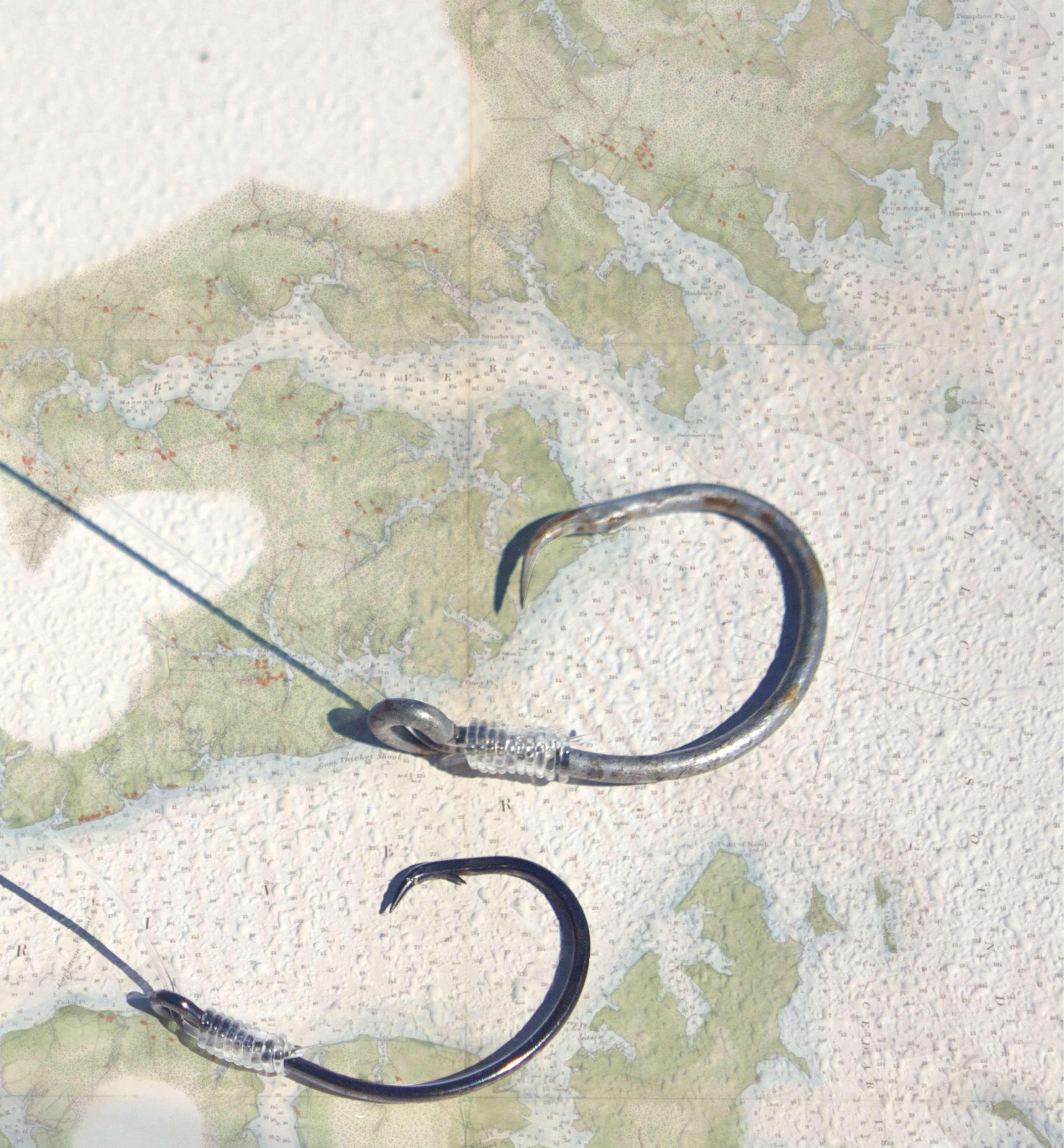
Named for a local Neuse River guide, these Owen Upton redfish rigs help eliminate gut-hooking.
During our afternoon outing, we caught and released seven giant drum topping 36 inches. I scored my personal best, a monster pushing 50 inches and 50 pounds. Two other guide boats fishing nearby tallied 25 and 36 reds apiece with multiple anglers.
“We average 10 fish per trip during the peak spawning season,” he says. “A good day is where everyone on the boat catches a couple citations apiece. A North Carolina citation red is one 40 inches or longer. It’s not unusual to land 30 fish, and the best I know of is 62 on a trip. But when you’re talking about fish of this size that pull as hard as they do, it’s all good. Especially when you know they’re going to be here year after year. As long as we continue to protect them.”
To book your own Neuse River Love Fest for giant red drum, contact Capt. George Beckwith at (252) 671-3474 or visit downeastguideservice.com.



Mark Sosin and Bill Dance reflect on the sport they’ve helped define.
by GHM Staff
An award-winning writer, photographer, radio personality, and television producer, Mark sosin has been covering sport fishing for decades. He is the author of 30 books and his popular television show, Mark Sosin’s Saltwater Journal, is in its 27th season. He is enshrined in several honorary halls, including the International game Fish Association.
Widely recognized as bass fishing’s first superstar, Bill Dance won 23 national bass tournament titles before retiring from competition in 1980. He’s written seven books on the sport and starred on the Bill Dance Outdoors television show, filming more than 2,000 episodes since 1968. Dance has also been honored by several angling organizations, including the IgFA. CA: What’s the toughest fish you ever caught and Why? MS: One of the toughest fish I ever caught was a 53-pound, 6-ounce yellowfin (Allison) tuna in Bermuda from an anchored boat on a 10-weight fly rod. Until then, no one ever talked about dead drifting a fly in a chum slick. I figured it out in desperation when the tuna kept refusing my offering. The battle raged for over an hour and the fish totally stripped all the line off the reel right down to the knot on the arbor twice. BD: We filmed a television show in Destin, Florida, and I managed to catch two, 10-pound sheepshead during that taping. What is amazing to me is how light those fish bite. You really have to concentrate to catch ‘em. We titled that show “Light Biters, Big Fighters.” You have to focus or you’ll miss a sheepshead bite. They are the toughest little fish I’ve ever tried to catch. But then again, any fish can be tough at certain times.
CA: Who is your favorite fishing partner? MS: My father was my favorite fishing partner. He helped me catch my first fish when I was three years old and instilled in me a love for the sport. Dad was patient and understanding as I learned to fish and kept taking me with him whenever he could. In the process, not only did he teach me to fish, but proved to me that fishing embodied skill rather than luck. BD: My grand-daddy got me interested in fishing. He taught me a lot in those early days, sitting on the creek bank beside him in middle Tennessee. He’d tell me how to read the currents, the transitional zones, and eddy waters, what fish do. He was the most instrumental of all in getting me started in this great sport.
CA: WHAT Is YOUr BIggesT LIke Or DIsLIke ABOUT FIsHIng TOUrnAMenTs? MS: In my mind, fishing always encompassed
a personal challenge between the fish and me. The ultimate experience is sight fishing, spotting a fish before you cast and getting it to eat your bait. Then, it’s a one-on-one game. My only tournament experience has been in celebrity events for charity, yet it became obvious that tournaments tend to bring out some of the worst traits in people if they feel they have a chance to win. BD: Tournaments opened a lot of doors for me. They helped me become a better fisherman. I learned to fish different types of water and was introduced to many different techniques. I wouldn’t be where I am now if I hadn’t spent those 14 years competing in tournaments. But toward the end, my anxiety level was so high and I was going so hard, traveling all over, that I finally gave them up.
CA: IF YOU OnLY HAD One LUre Or FLY TO Use THe resT OF YOUr LIFe, WHAT WOULD IT Be AnD WHY? MS: If I were limited to one lure for the rest of my life, it would be a white, lead-headed bucktail jig. To me, this is the universal lure and I have taken more species on it than I can count, from bonefish to sailfish. I may or may not hang a plastic worm on the bucktail’s hook. The bucktail is completely versatile and can be fished from the surface to the bottom with equal success. BD: My go-to bait under any adverse conditions would be a 3/8-ounce black spinnerbait with a no. 5 silver Colorado blade. Why? That weight and blade size is the most universal. Black holds its identity better than any other color in a variety of conditions. The silver finish on the blade reflects better than any rainbow color. And a Colorado blade has more water resistance and tremendous vibration, so you can work it slower and effectively throughout the entirety of the water column.
CA: WHere Is THe MOsT CHALLengIng pLACe YOU ever FIsHeD? MS: several situations come to mind for my most challenging trip. But I would have to pick one in particular with a captain out of Tumaco, Columbia, in the pacific. We were fishing aboard his 52-foot boat powered by twin Ford, six-cylinder tractor engines. I had fished with this captain before off Costa rica and he was impressive. In Columbia, however, he had discovered drugs along with his deckhand. We had one meal a day and were “lost” for two days. Finally, faced with torrential rains, we decided to go in at night. The captain and mate were both sound asleep below and I brought the boat in from 35 miles offshore in driving rain with whole mahogany trees floating in the water. Finally, we made it into the harbor and anchored. An Indian picked me up in a true dugout canoe and raced for shore with me paddling in the bow. If you’ve never been in a dugout, it’s a ride you’ll never forget. BD: Any place you fish can be a challenge and that’s the truth. The sport itself is a challenge. I don’t care how determined you are. When you compete against Mother nature and her creatures, you’re not going to win every time. There will be days you’re on top and days you lose. And that’s where the real challenge comes in.
CA: WHAT Is THe BIggesT IssUe FACIng fisheries? MS: There are actually two major issues facing sport fishing. The first centers on getting young people involved in it. The youth of today spend more time playing video games and chasing other pursuits than they do thinking of outdoor recreation and going fishing. We need to find a way to encourage more young people to become fishermen. At the same time, it’s imperative to protect and manage fish stocks on a worldwide basis. Without fish to catch, few people will take up the sport and those already committed may look for alternative avocations. BD: Our river systems, the tributaries, and ox-bow lakes are absolutely infested with Asian carp, and these invasive fish keep spreading. They have no predation other than catfish and cormorants, and they occupy so much available water they’re displacing our native fish. It’s ruining our freshwater fishing and the situation is only going to get worse until something is done about it.



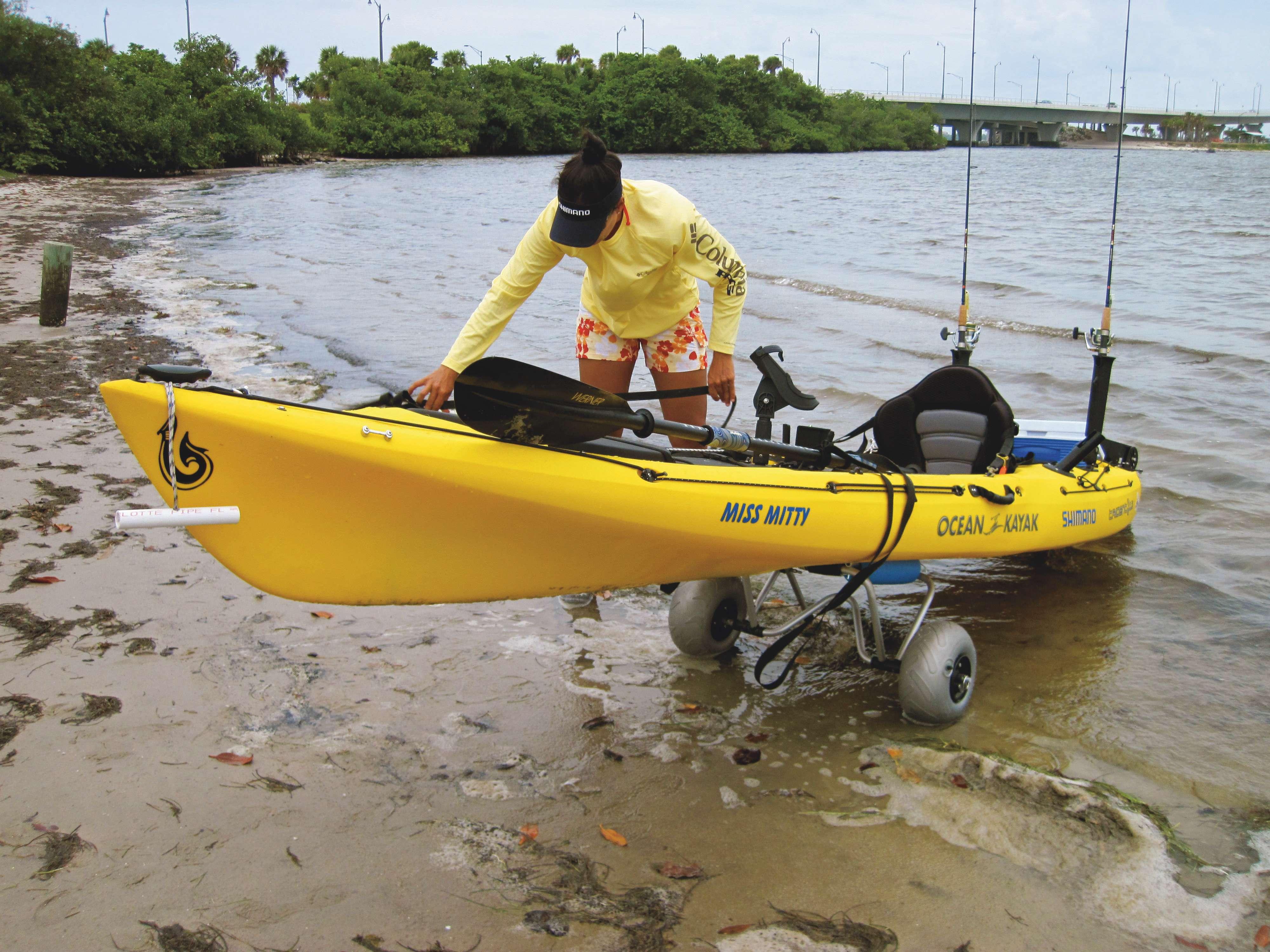
Kayaks are small, but they can produce big results, like this healthy speckled trout (left). Anglers can also maximize fishing time by using a car t (right) for quick and effor tless launching.
In or out?
The choice of boat is obviously the first consideration. Two lines of kayaks have evolved from the skin-covered, individually sculpted hulls that transported Arctic hunters a millennium ago: the Sit Inside Kayak (SINK) and the Sit On Top (SOT).
Long associated with cold-water use, the traditional SINK cockpit, equipped with a splashproof spray skirt, offers lower-body protection from the elements. Because the paddler is virtually seated on the floor, a low center of gravity enhances stability.
Southern anglers overwhelmingly prefer the Sit On Top version, especially for wade-fishing, which is popular on Florida grass flats and a recognized religion among Texas fishermen. The reason: slipping over low SOT gunnels is far easier than the contorted gymnastics necessary to access the hatchlike SINK cockpit. Waders can opt for a canoe-like open SINK, but these lack scuppers, making them questionable for use in choppy conditions. The raised SOT deck allows for self-draining scuppers, which keep water from accumulating on the deck and swamping the kayak. And in the event of a rollover, no bilge pump is required to clear water from the cockpit of the sealed SOT hull. Flip it over, crawl back in, and go fishing. nIce Wheels
I’m pretty sure kayaks have gotten heavier as I’ve gotten older, because hoisting them over my head isn’t as much fun as it used to be. Unless you back right down to the water or have a partner share the load, a kayak cart takes the weight off your shoulders and speeds launching and loading. Pull the boat off your vehicle, pop it on the cart, and load it up like a wheelbarrow. Seats, paddles, cooler, anchor, tackle— it all wheels down to the water in one trip, which also minimizes exposure to the dawn and dusk bug bite. Utilizing a wheeled cart also prevents the gouging incurred from dragging a thin plastic hull over rough terrain.
There are a number of universal strap-on carts on the market. However, Hobie’s Plug-In Cart personifies simplicity. Slip it into the scuppers under the tank well, and you’re ready to roll. Light, compact, no straps. The bad news: it only fits a Hobie.
calloused KayaKers
A few select kayaks feature raised mesh chairs, but standard seats generally leave a lot to be desired in terms of comfort. Some manufacturers don’t include a seat, period. Either way, unless your paddle sessions are very short, your butt is likely to demand an upgraded seat in short order.
My fishing day may consist of 12 hours in the saddle, so I’m picky about what I sit on, and don’t mind paying for it. Inflatable seats are comfortable and relatively inexpensive, but in my experience, their air bladders often enjoy a limited life span. My preference goes toward an adjustable high-back seat with a zippered storage pocket, a 2-inch-thick foam cushion and saltwater-grade hardware, such as those offered by Surf to Summit. They’ll set you back $125 to $200, but quality seats are accompanied by a lifetime warranty.
These seats fit virtually any kayak, but may require the installation of plastic or stainless anchor points in the cockpit and tank well to secure them in position. If you have a nearby storage hatch that provides interior access, installation is simple and requires nothing more than a drill, screwdriver, and wrench. Spend the extra buck on stainless bolts, nuts, and large backing washers. Lacking access to mounting the washers and nuts from the inside, use a rivet gun to lock the anchors in place. These, or additional anchor points, are also handy for attaching paddle and rod leashes to the hull if you kayak offshore or in rough conditions.
Your hands might also appreciate a little padding. Foam Yakgrips ($14.95, www.cascadecreek.com) are cheap insurance against blisters and hand fatigue.
Protect thyself
Gear gets wet aboard a kayak, and salt water devours metal and electronics. Store cell phones and cameras in watertight cases or plastic storage bags. Waterproof cameras are even better. Spray fishing reels internally and externally with water-displacing, anti-corrosion protectants, and perform routine maintenance on a regular basis.
Kayakers are also exposed to the elements far more than boaters. Polarized sunglasses, nylon wading pants, long-sleeve shirts, and wide-brim hats should complement the lavish use of sunscreen in the summer. Light, breathable waders over layered clothing deflect winter waves and wind.
hold It doWn
Modern kayaks intended for anglers typically feature a pair of molded rod holders behind the seat. These are perfectly adequate for most grass flats snook, trout, redfish, and pompano expeditions, especially for waders. The last thing kayakers should do is add weight, clutter, and prep time by clamping on extraneous gear. The exception comes if you troll. Outward-angled rod holders emulate big-boat outriggers, spreading the rod tips and greatly reducing crossover tangles on turns. Although they may be sold under a variety of names, Scotty (www.scotty. com), Ram (www.ram-mount.com) and Driftmaster (www.driftmaster.com) produce most of the holders on the market. The contours of your kayak and available deck space may determine which you choose. Positioning them can be a tricky proposition—think before you drill.
If the holders simply serve as rod storage, placement isn’t critical; stick them where they won’t interfere with casting or paddling. If you intend to troll, however, place them in front of the cockpit so you can see the rod tips subtly bend if you snag a weed. Holders need to be mounted far enough forward so that they don’t interfere with paddling, but not so far forward you can’t reach them.
Rod holders require the mounting of permanent bases, which come in various shapes and sizes. Large square or rectangular bases may not be compatible with the limited flat spaces available within the confines of a kayak cockpit. Gunnel mounts especially dictate the use of narrow rectangular or diamond bases. Backing plates or large washers are mandatory; a big offshore fish striking at 50 mph might otherwise rip a holder out of a thin-plastic hull. As always, stainless hardware is essential.
cool It
I’m mostly a catch-and-release guy, but I make an exception when the pompano invade my trout flats in the winter. A small Styrofoam box inside the front hatch, or secured by bungee cords behind the seat, easily ices lunch, drinks, and a couple pomps.
Offshore anglers transporting a cobia, amberjack, grouper, or kingfish back to the beach face a tougher task. Strap a center console fish box onto your kayak, stuff it with fish and ice, and you’ll need a snorkel and periscope. Shaped to fit the curvature of a kayak, soft-sided fish bags from Kingfish Koffin or Surf to Summit feature an inch of insulation, yet slide easily inside most front hatches or bungee to the rear deck without adding unmanageable weight or dangerously threatening your center of gravity.
no anchor clanKers
Given a kayak’s weight and space limitations, the compact, 1.5-pound folding anchor seems like the perfect tool for the job. But I have two problems with it. Folded up, it clanks around on the deck, the sound undoubtedly transmitting through the hull. Worse, if you have to deploy it in a hurry with one hand, it may not grab something solid before that big snook drags your kayak into the mangrove roots or dock pilings. Depending on the depth and bottom composition, I prefer a tall, flexible stick anchor, such as the 7-foot Stick It Anchor Pin, or a lead-filled
You may not need all these accessories, but each can make a significant difference in how well your kayak functions as a fishing platform: (top, left-to-right) digital camera, depth finder, padded oar handles, properly sized mounting hardware, soft-sided fish bag, rod holders, proper footwear, anti-corrosion protection for reels, paddle, tube anchor, kayak cart, and custom seat.










copper or aluminum tube anchor with bendable wire grappling legs. They’re cheap, easy to make, store silently, and hold bottom flawlessly.
lIve BaIt deBate
Two dedicated kayak livewell systems have come on the market in recent years that keep larger baits such as sardines or mullet happier than the traditional 5-gallon bucket fitted with an air stone. The advantage of either is that they prevent the buildup of heat and waste products by circulating fresh water through the tank.
Shimano offers a soft livewell bag that fits virtually any kayak. Hobie’s hard-plastic model is designed specifically to overlay Hobie drain holes to draw and dump water through the scuppers. The overflow is height-adjustable and regulates the amount of water in the tank. Vertical rod holders attach to either model.
Now, let me play devil’s advocate and lay out the downside to kayak fishing with live bait. First, there’s the time factor. Why spend what is often the most productive hour of fishing collecting bait instead? Fish are least wary in the low-light hours of early morning and readily susceptible to artificial lures, which also enjoy the benefit of prospecting immensely more water.
Second, combine the weight of a cast net with a livewell full of water at eight pounds per gallon, and the kayak is now crowded, top-heavy, and slow. Worst of all, consider the noise. Aeration systems are fine in 10-foot depths or offshore. But in two feet of water, where stealthy kayaks excel, electric noise (this goes for trolling motors and sonars, as well) radiates through the hull and announces that all is not well in Mr. Rogers’ neighborhood.

fInal thought
A well-appointed kayak can provide transportation, stealth, and all the tools necessary for a productive, successful day on the water. Accessorize with care and you’ll fish as smart as you feel. Kayak fishing can provide access to hard-to-reach shallow waters and a stealthy approach for fish that are normally skittish.


